

Majorelle, a stunning garden with bold use of primary colours.
See Moroccan Gardens, page 52.




Majorelle, a stunning garden with bold use of primary colours.
See Moroccan Gardens, page 52.


[4] FROM THE GARDEN What brings you to the garden?
[5] THANK YOU
Hearts & Flowers 2023 tops goal
[6] SAVING THE RAVINES collective strategy needed to stop decline
[10] SUSTAINABLE CATERING Zero-waste take-out platform inspires climate action [11] HELLEBORES every garden should have some [14] FLORAL DESIGN courses offer skill training and fun
[17] AUTHOR TALKS Meet howard rideout at Members’ lecture [18] GARDEN FOR ALL tbg marks garden accessability Week [19] TBG BOOK CLUB SEEKS NEW MEMBERS [20] SWANSEA through the garden gate, June 8 & 9 [25] WHAT’S ON Spring/Summer 2024 [26] GARDEN SHOP duo turns used boat sails into stylish bags [27] TBG VOLUNTEERS a wonderful talent base
[28] HISTORY OF GARDENING labyrinths and Mazes [32] PEAT MOSS alternatives offer a solution [34] PROS & CONS Are peat benefits worth the risk?
[36] HARBINGERS OF SPRING A play that changes year after year [40] HIDDEN IN PLAIN SIGHT trees at Mount pleasant cemetery have stories to tell [52] MOROCCAN GARDENING Sheltered respites from outside world
[60] ODE TO THE DANDELION Just weeds or valuable environment contributors?
[64] BOOK SHELF
[68] DIY INDULGE YOURSELF coffee bean Massage bars
[69] PUZZLE PIECES [70] GOOD THINGS ARE HAPPENING Winter blooms a big hit
The ToronTo BoTanical Garden has been getting curious about what brings people to the Garden, whether for a first time visit or repeat visits. While our team of staff and volunteers works hard every day to make the Garden a desirable destination, it is important that we pause and take the time to discover what draws our diverse community to the Garden and adjacent natural places. Through the generosity of a donor we have recently been able to engage our members, digital community and general visitors on what TBG means to them and why they visit TBG.
hands down, respondents, both our highly engaged members and our general visitors, tell us that:
These responses from people that we know and we are looking forward to meeting continue to guide TBG to our north star of being a garden for all, a diverse community that recognizes the life-giving role of nature, working together for a more sustainable world.
While we have more work to do in many directions to achieve our vision, it is affirming to know that we are on the path to achieve it, and that you, our community of garden champions, are helping us reach this vision. Read more about the range of accessible programs we offer our diverse audience as we embrace National AccessAbility Week May 26 to June 1.
Knowing that our community is seeking connections to nature and contributing to a more sustainable world, we are excited to share this issue of Trellis with you. In particular, take time to read about the 2023 Urban Ravine Symposium on page 6, with highlights from our three speakers on how we can continue to embrace, steward and engage our diverse community in Toronto’s Ravine System. And learn about an option to be more sustainable through catering and takeout meals with Inwit, the caterer for our 2023 Symposium on page 10.
“We

Be inspired by one of my favourite plants, hellebores, on page 11. Learn why you will want to make a point to explore some of our nearby natural areas including Mount Pleasant Cemetery and some of Ontario’s Labyrinths. And get a sneak peek at our much anticipated 2024 Through the Garden Gate tour in the Swansea neighborhood June 8 & 9.
See you in the Garden soon!
Stephanie Jutila Executive Director
tbg hearts & Flowers campaign 2023 tops its goal
By Aleeshia Carman Grant Writer & Development CoordinatorHello!
Did you hear all about how the Toronto Botanical Garden community showed up for nature, supporting the largest Hearts & flowers campaign to date? Thank you to all 281 generous donors who raised $182,203 in support of TBG. With your investment, we can provide the Garden with essential operational and core mission support, including year-round programming, beauty and nature-based experiences for our community.
We accomplished our 2023 Hearts & Flowers campaign goal because of you. It was a team effort, with many TBG champions sharing their personal philanthropy and inspiring the community to give to the Garden by matching donations. We are thrilled to have successfully achieved the Giving Tuesday match, as well as closing out the year strong with a second match, raising an incredible total of $77,055. A special thank you to the generous matching donations from Joan and Jerry Lozinski, our strategic partners, the greater, the Cullen family and an anonymous Friend of the Garden.
This year-end campaign is one step in our larger annual fundraising goal. Gifts are given in many ways and during different times of the year, so no matter how you choose to support us, we deeply appreciate it. We’re grateful for
LEArN ABouT how you can support the Toronto Botanical Garden throughout the year. Find out more at https://torontobotanicalgarden.ca/ development/donation-opportunities/.
PErSoNAL DoNATioN A personal donation of any amount directly supports TBG’s core operations like providing year-round programming, caring for nature and beautifying the Garden.

your investment in Hearts & Flowers, and in any other ways you choose to support us. For donors in search of flexible giving opportunities, we launched our monthly giving program. Now you can invest in our horticultural activities and all-ages learning programs year-round.
Soon spring will arrive, and flowers will start to bloom, just as we launch Gifts to the Garden. This campaign provides a unique opportunity to sustain the beauty of the Garden, foster a closer connection with nature, and create more environmental-based activities by purchasing specific items for the Garden and programming. Stay tuned for more Gifts to the Garden information that will be released in April!
Thank you for your support through the year. Together we are creating a more vibrant garden and dynamic community hub for Toronto.
MEMBErShiP Become a member to support the Toronto Botanical Garden, a one-of-a-kind experience, connecting plants to people.
GifTS of SToCk support our dynamic community hub and donate securities. Receive a tax receipt for the full appreciated value of your gift by donating to support our essential dynamic community hub.
TriBuTES Purchase a tree or shrub to show your commitment to the Garden for years to come. speak to our Membership Coordinator to find out how to make this special gift at membership@torontobotanical garden.ca.
Visit the website at https://toronto botanicalgarden.ca/donate-today/to support the Garden you love today.

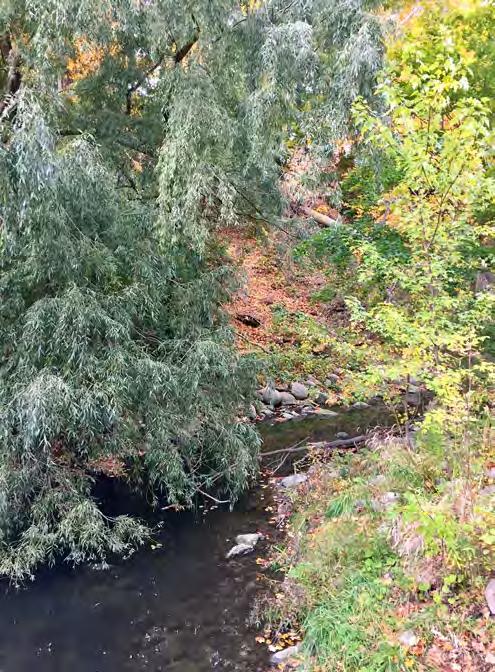

W e may approach Toronto’s ravines from different perspectives but we all want the same thing – to protect them and ensure they stay healthy for our children and grandchildren. And the way to ensure that is to work together to make it happen. That’s the message I took away from the TBG’s 2023 Ravine Symposium.
The three major speakers looked at the ravines through their own lenses but everyone stressed the importance of relationships.
relationships are the foundation of everything, says Carolynne Crawley, an expert on social, food and environmental justice. She grew up in Mi’kma’ki territory, aka Nova Scotia, is of Mi’kmaw, Black and Irish background and brought an Indigenous perspective to the event.
“Healthy relationships with ourselves, the land and all living beings are all intertwined,” she said. “They are all our relations – to be treated with as much love, respect and reciprocity as we do with our human loved ones. Whatever happens to the land impacts us all. If we break the threads, we compromise the strength of the land.”
To end her talk, Crawley took the entire audience of more than 200 people out into the courtyard to experience the land from a sensual perspective using our sight, hearing, touch and taste to connect.
Speaking from a Black perspective, Jacqueline L. Scott pointed out that “living near is not the same as having access.” Jacqueline is a PhD candidate at the University of Toronto, Department of Social Justice Education. “Imagine sitting in your living room and looking out the window at a beautiful ravine. Now imagine looking out at another concrete building. Wouldn’t you rather be looking at Paradise?”
“Why care about Black people? she asked, echoing the symposium’s theme of Why? “Because there is a long Black history in Canada, even if it isn’t always readily available.”
In the National Geographic National Parks of Canada, for example, there are about 500 pictures and not one includes a Black person, she pointed out. “So, after 400 years, we don’t exist? Officially?” she asked. “Diversity is the fabric of Canada. We (non whites) are in the majority in Toronto. So, if we are not there, who will care for the land?



“the energy is there but someone needs to steer the ship.” Danijela Puric-Mladenovic
“We need programs in neighbourhoods where Black people live. Nature needs help in these areas across Toronto.” WayS to make Black people feel welcome in the ravines, she suggested, include:
• Put up maps and way-finding information. “I discovered the ravines through outdoor activity. But if there are no maps and signs, you might not go into the ravine because you don’t know how to get out.”
• Form relationships with diverse groups. “Become a mentor.”
• Take urban ecology seriously because some people only have access to urban ecology.
• Transfer resources directly to Black people or groups. “Don’t just put one person on a subcommittee where a white person controls the funds. That person may be at odds with the needs of a Black group.”
• Hire Black and other minority staff.
• Set goals. “When Black people see themselves in programs, they are more likely to believe there is a spot for them.”
During the COVID pandemic, huge numbers of people rediscovered nature and more Black people were using the ravines, Scott said. “We are still in the ravines. We are not going away. So, give us the power and money so we can engage on our terms. We all need to be here and saving the ravines.”
the state of the ravines yesterday, today and in the future was the theme of Danijela Puric-Mladenovic, Assistant Professor at University of Toronto Faculty of Forestry. They were formed, she said, by melting glaciers from thousands of years ago but the changes really came when European settlers arrived and began clearing the land for agriculture. The area went from 90 to 10 per cent forest coverage over just 50 years. Over the past 200 years, the land that was too steep to grow anything became the ravines.
White cedar that once dominated the forests and the American elm, which used to grow in both wet and dry lands, were lost because of land clearing. “Once land is cleared for agriculture, you don’t get it back. Some of the
once dominant species, however, are still found in private gardens, patches and stands.”
The general population, she said, has no idea about the land where they live. If you don’t know what you lost, how are you going to appreciate what you have?”
Today, there are all kinds of garden plants in the ravines that did not originate there, such as flowering almond ( Prunus triloba ), witch elm, English ivy, which is very invasive, forsythia and ground ivy. Parsnip chervil, she said, was found in Kings Hill Park, near the Old Mill Subway Station, and it turns out there used to be a market vegetable garden on that site. And then there are the early spring ephemerals like wood anemones and yellow and white trout lily. Scilla and lily-of-the-valley have moved to the ravines from private gardens, their seeds carried by ants.
Of some 582 plant species, about 30 per cent, she said, are invasive. There are more invasives in fragmented areas of ravine forest than in larger forest areas. “When you build a house next to a patch of old forest, you are not saving it. You are slowly killing it.”
The whole landscape needs to be dealt with, she said. “It is not a job for any one group. There are over 100 groups out there digging and planting. But we can’t do it on our own. We need to know who is doing what. There is tons of overlap and competition for money.
“The energy is there but someone has to steer the ship. It has to be a collective strategy. Coordinated efforts need to be made to keep the biodiversity from declining further.”
In her closing remarks, TBG Executive Director Stephanie Jutila asked attendees to commit to how they would like to be involved by filling in a Registry of Action. “We need action to pool inspiration and resources as a community; to amplify what’s begun and start new things to ensure that the ravines are safe places for all members of our community.”

AttenDeeS at the Toronto Ravine Symposium enjoyed delicious food and were given a glimpse into innovation by a trailblazing sustainable catering company, Inwit.
Canada’s first zero-waste take out platform, Inwit partners with local restaurants to deliver meals using reusable packaging – insulated stainless steel containers.
The company collects the containers at the end of the event, washes and sanitizes them for reuse.
“Our mission is to inspire and empower people to act on climate change. Working together generates positivity because we see how these tangible steps are creating a sustainable tomorrow,” says co-founder Erika Reyes.
Inw


InWit’s RestauRant paRtneRs are at the forefront of culinary innovation, curating personalized menus that embrace authenticity and emphasize organic, seasonal and locally sourced ingredients. partners also cater to diverse dietary preferences. to minimize carbon emissions, inwit partners with Send it, a toronto-based courier company that exclusively employs bicycle couriers. the goal? to foster a sustainable workplace culture by reducing waste created by corporate events and meetings. normally an event like the ravine
Symposium, with 300 people, would generate 12 garbage bins. h owever, there was only one garbage bin at the end of the event — a testament to i nwit’s waste-free philosophy.
“We became environmentalists by accident after watching a documentary about plastic pollution.” Wanting to support the environment, erika, with partners clément bureau and Mohammad tahvili, founded Wisebox in 2019. it was the first pilot for reusable packaging in canada’s take-out industry and laid the foundation for inwit. inwit is ranked one of the top 15 tech Solutions worldwide building low-carbon cities. inwit’s audacious ‘Mission 2025’ aims to transform at least 85 per cent of its corporate events and meetings with a zero-waste ethos. the university of toronto has already signed on to this leadership commitment.
“We are excited about the engagement we see with inwit; we want to take our zero-waste model across canada, north america and beyond,” says erika. “it is heartening to hear our clients and their guests describe the inwit experience as both delightful and surprising.” learn more by checking out their website https:// inwit.ca

low-maintenance, easy to grow — every garden should have someBy Veronica Sliva
One of the best hellebore hybrids is a double-flowered series called WEDDING PARTY®. It debuted in 2015, an effort of years of work from Walters Gardens hybridizer Hans Hansen. In his breeding work, he selected plants with notable vigour, showy floral displays with large numbers of blossoms per plant, and rich flower colours including black, mauve/purple, white, yellow and pink. With names like True Love, Black Tie Affair, Blushing Bridesmaid and First Dance who can resist? In the spring sale other varieties such as Ice and Roses, Merlot, Niger (True Hellebore), Picotee Pearl and many more will be available.

s I wrIte thIs pIece on hellebores, I have just had a wander around the shadiest part of my garden. There is no snow right now so it’s easy to poke around the dead leaves and debris left from last season. As I move the brown bits, I can see flashes of white and I know that I have found the nodding blooms of the hellebores I tucked in among the shrubs late last spring. What a treat to find these lovely flowers blooming on a bleak winter’s day. Every garden should have some. Hellebores are low-maintenance and easy to grow. Planted in groups they are great candidates for naturalizing in areas where the clumps can slowly spread through self-seeding. They make amiable companions for snowdrops, crocus, muscari, daffodils, trillium and bleeding heart. And, rabbits or deer aren’t attracted to them because hellebores are toxic to people and animals.



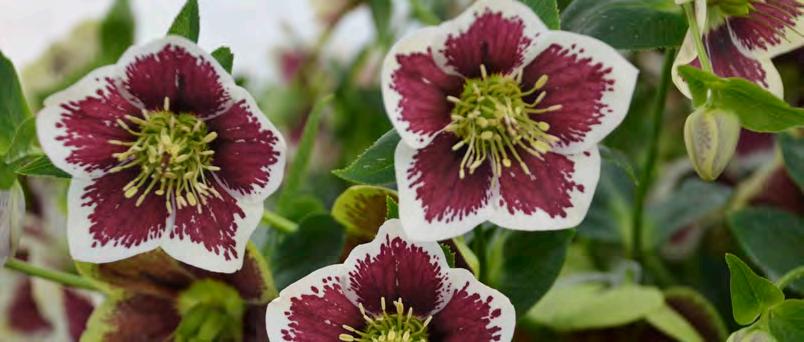
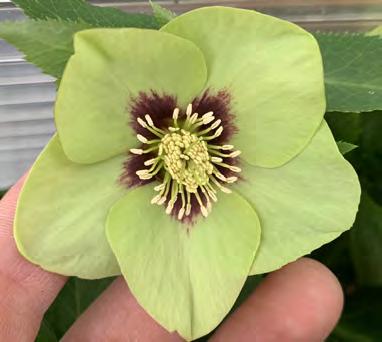


 Mother of the Bride
Shotgun Wedding
California Dreaming
Romantic Getaway
Irish Luck
Childhood Sweetheart
Whirlwind Romance
Black Tie Affair
Mother of the Bride
Shotgun Wedding
California Dreaming
Romantic Getaway
Irish Luck
Childhood Sweetheart
Whirlwind Romance
Black Tie Affair
Types of Hellebores there are more than 20 species of hellebores, most native to the mountainous regions of europe. there are four main varieties which are the most popular types available commercially.
christmas rose (Helleborus niger) In mild winters Helleborus niger tends to bloom around Christmas time. Legend has it that a young girl visited the baby Jesus in Bethlehem shortly after his birth and because she had nothing to give him she began to cry. In the spots where her tears fell to the ground, hellebores bloomed (vaguely resembling roses), hence the name Christmas Rose. The large (8 cm), bowl-shaped flowers are mostly white and feature a crown of golden-yellow stamens with sepals that fade to green or pink as they mature. The flowers are borne on short, thick stems and unlike most hellebores face outward. This hellebore type makes a very good cut flower.
Lenten rose (Helleborus orientalis) blooms during the time of Lent, a six-week period in the Christian calendar that leads up to Easter. Hence the name Lenten. This type is considered the most colourful species in the genus with many hybrids. The large flowers come in colours from creamy white to almost black and in a variety of flower forms (single, semi-double and fully double). Mature plants can have 50 or more flowers that last up to two months.
Many will self-seed around the garden. This delights some gardeners because the offspring are likely to look different from the parent plants. And who knows, a seedling may result in a fabulous new colour variation! The plants typically take two years to bloom when grown from seed.
stinking hellebore (Helleborus foetidus) typically grows to 60 cm (24") tall and is noted for its deeply divided dark green foliage. Clusters of drooping, bell-shaped, greenish-white flowers appear around February. The flowers and bruised foliage can produce an unusual scent, hence the name (foeditus meaning fetid, a synonym for stinking). Although the foliage is evergreen, it can become tattered and torn in harsh winters, especially if there is no snow cover.
corsican hellebore (Helleborus argutifolius) is a large, bold plant that grows 90 cm (3 ft) tall and can spread up to 1.2 metres in diameter when mature. It is evergreen with large leathery, sharply-toothed blue-green leaves sporting large clusters of 20 to 30 nodding, pale green flowers that bloom from late winter to early summer (January to March or April). This plant adapts to sun or shade and grows well in a variety of soils. It usually self-seeds prolifically and the seeds germinate easily.
Hellebore Hybrids Fifty years ago there were few colours or forms of hellebores available commercially. The plants had to be propagated by division and were slow to increase, making them very expensive for home gardeners. Nowadays hybrids are very affordable. Thanks to refined breeding programs there are more diverse colours from amber/gold shades to the darkest purple with more exotic patterns of speckling, veining and picotee edges. There are
new flower forms including outward-facing blooms, as well as increased plant vigour and larger blooms.
For those who see self-seeding as a nuisance, modern breeding has produced some varieties that are sterile and will not produce viable seeds, including the Brandywine and Wedding Party series.
• Be careful not to plant your hellebores too deeply as this can hinder flower production. Make sure the crown of the plant is just slightly buried beneath the soil.
• Tolerant of a wide range of growing conditions, hellebores perform best when in partial shade in rich, moist, but well-draining soil.
• After winter the foliage can become tattered and torn. The damaged foliage can be cut back to the base.
• Cut back flowering stems after blooming to promote new foliage growth.
• Established plants can be divided in late summer to early fall.
• An annual application of compost will help to boost the growth of your hellebores.
HELLEBORES CONTAIN toxins that are harmful to pets and humans. its name is said to come from greek words for “to harm” and “food.” there are many legends surrounding this plant and most of them are grim. Here are a few:
• It is said that Alexander the Great was poisoned by his assistants when powdered hellebore root was placed in his drink.
• The ancient Gauls dipped their arrowheads in hellebore powder to make sure their enemies would die.
• During the invasion of the city of Kirrha, the Greeks poisoned the city’s water supply with hellebores to make the defending armies of Kirrha so weak and sickened that they could not protect their city.
• Both Dioscorides and Pliny recorded that if an eagle saw you digging up a hellebore, you would die within the year.
• Witches in medieval times summoned demons with an ointment made from hellebores that allowed them to fly.
Though all of these myths seem absurd, up until the 18th century hellebore concoctions were prescribed to treat digestive issues and worms. Unfortunately, some parents gave hellebore preparations to their sick children, resulting in their deaths.
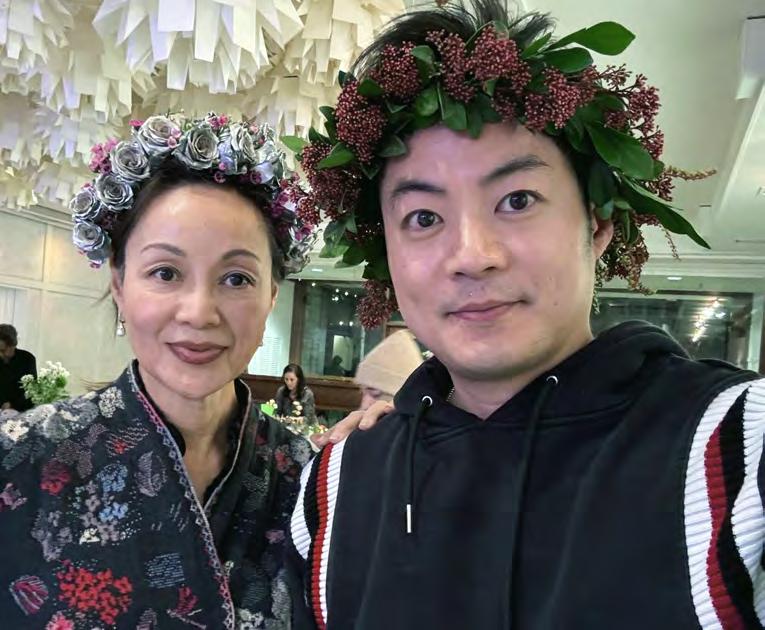
Designing with flowers isn’t as simple as trimming stems and popping them into a vase. Rather, floral design is an art form with flowers as the medium. It is, as TBG instructor Margaret Betts aptly describes, “ephemeral sculpture”.
There is a 3-D element to design that may come naturally to some, but which others must learn. From understanding different types of flowers and foliage to mastering colour combinations and arranging techniques, students of floral design learn strict rules about presentation, design and use of materials while developing valuable skills that allow them to express their
creativity through floral arrangements.
In 2008 Margaret Taylor created the Floral Design Program at Toronto Botanical Garden. Here she thoughtfully nurtures instructors (all of whom are floral design judges accredited by the Garden Clubs of Ontario), leads the creative direction of the program (including curriculum design) and takes great joy in teaching.
Margaret is an internationally known and accredited floral design judge, teacher, and demonstrator deeply involved in many aspects of floral design for a quarter of a century. Her designs have been published, she has performed demonstrations,
exhibited and judged internationally (Oman, Orlando, Ireland, Barbados), nationally (British Columbia), and locally (Canada Blooms) and has represented Canada at the World Association of Floral Arts (WAFA) in Jaipur, India. Margaret is an a judge with Garden Clubs of Ontario (for which she has acted as co-chair), the Royal Botanical Garden, the Canadian Society of Rose Judges and is a first grade Sogetsu Ikebana teacher, accredited by the Sogetsu Foundation in Tokyo.
When I first met Margaret, after speaking for many months on the phone, she greeted me with a huge, warm hug (like many other instructors). And that warmth and passion for floral design is exuded by all the instructors at TBG.
Lil Taggart, a self professed ‘floral design addict’ and TBG instructor, is Chair of the Judges Council of Ontario Judges of the Garden Clubs Association and past-Chair of the board of Canada Blooms. She’s been abroad with WAFA and has judged several times for IFFAD (International Friends of Floral Art and Design) based in Great Britain. Lil stresses the importance of learning the classics; roots are needed before you can branch out. She insists that floral design is “extremely satisfying, doable and not something to be afraid of.”
While the primary focus of the Floral Design Program is to enhance participants’ design skills, the sense of community that emerges from the program is an unexpected but invaluable outcome. The shared passion for floral design brings people together, creating a space where individuals can connect, form friendships and support each other’s

creative journeys. Participants are encouraged to actively engage with each other, promoting a sense of peer review but also of belonging and camaraderie.
The program fosters a supportive learning environment where participants can freely express their personal styles. Each course is comprised of four classes. In each class students learn how to create a specific design related to the theme, such as Designing with Glass or Modern Design. They are given material lists and every single time, I marvel how, with the same material requirements and the same design goal, each individual work is reflective of the personality and tastes of that designer. At the end of each class, students gather to assess each others’ work (there may be heckling involved if it’s a close group!) and the instructor gives constructive feedback, often moving a branch just a few degrees or removing any superfluous element. Participants are guided in building a solid foundation in floral design that they can use to enhance their homes or open potential career
opportunities for those interested in pursuing a career in the floral industry.
There is a lot of learning, but there is also a lot of fun in these classes. Lil says, “The camaraderie is normal. Permanent friendships are formed.”
Caprice Chow and her nephew Kinson Chow are a family duo who took their first floral design class in January 2023, which Kinson had gifted to his aunt for her birthday. Caprice insisted Kinson join her, he reluctantly agreed, and they’ve been learning together ever since. They bond over their weekly excursions to pick out their flowers, their classes with Pat Ware and, of course, their shared creative passion. Each time I pop into a class with sweets (as a bribe for ogling the designs and botanical choices) Caprice is either teasing someone or asking a question and Kinson is diligently working on his design.
For Kinson it’s his first creative outlet and he’s a natural. “The most wonderful surprise was uncovering Kinson’s natural talent. The oohs an aahs he





receives when presenting his design at the end of each class are very gratifying,” says Caprice. For her, it’s a chance to become the artist she dreamed of being as a child. “It is a fantastic program. The teachers are nationally and internationally recognized judges. We not only learn to craft exquisite designs but also revel in the camaraderie of fellow students, creating an atmosphere of fun. The progress of each classmate is evident as the courses unfold.” Kinson and Caprice have found much joy in spending time together, and with their classmates, increasing their skills and gifting friends with their creations. They are unsure about the path ahead (competitions are calling) but both are eager to continue with the Advanced Floral Certificate.

Miranda, another Floral Design student, began her journey with the goal of working in the industry. She is preparing to run an events business, and, as a side benefit, thought she could learn how to do florals for her upcoming wedding. Beyond this pragmatic approach, Miranda has found her experience to be exhilarating, creating a sense of joie de vivre that extends beyond herself. Over the past year the closeness developed with her classmates has extended beyond the classroom. Not only do they keep in touch regularly with an email chat sharing designs and news of floral happenings, but several of her classmates (including Caprice and Kinson) were moved to volunteer to help out with fresh florals on Miranda’s ‘big day.’
“Floral design is not an antiquated, Victorian pastime,” Lil passionately espouses. “Handling plant material, the body releases endorphins that make you feel wonderful. You’re creating something beautiful, learning about plant material and learning to appreciate styles that you never considered before.”
As Margaret says, “I couldn’t put daisies in a jar when I started. Floral design is good for people who want to work with their hands, and those who want to explore their creativity. A lot of people think they’re not talented, not creative or they’re inhibited. Stop worrying and just try it!”
See the TBG website for details on Basic and Advanced Certificates and upcoming classes.
Three Landscapes: Pruned, Tangled, Wild, a TBG member exclusive lecture, will be presented by Ontario architect, illustrator and environmental advocate, Howard Rideout on Thursday, March 28.
Howard will present his photographs, sketches and drawings revealing three very personal landscapes he has nurtured for decades. The first is a city garden pruned to perfection (showcased in 2023’s Through the Garden Gate tour). The second is a large, tangled garden created for his parents which has reverted into a semi-natural state. And the third is a large wilderness preserve Howard has been imagining since he was a child and which only recently has come into fruition. All three illustrate the different ways we engage the natural world, reminding us that we are renewed and inspired by these interactions.
Howard graduated from Waterloo School of Architecture, then joined the Ontario Association of Architects and the American Society of Architectural Illustrators. He has
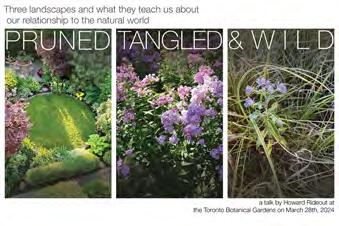
received numerous awards for his work, with environmental stewardship being a driving force in his design philosophy. Howard aims to create sustainable, harmonious spaces that reflect the relationship between built and natural environments.
You’ll also have the opportunity to pre-order Howard’s upcoming book, The Dorset Project-the Winters/Rideout Preservation Initiative which will be available for viewing at the talk. If you’d like to do a deep dive into Howard’s projects, take a visit to his blog Howard Rideout Architect Inc.
We encourage all TBG members to take advantage of this exclusive opportunity, to form connections with other TBG members and to delve into the fascinating world of architecture and environmental sustainability. Mark your calendar for this enlightening lecture, Thursday, March 28, 7 to 8:30 p.m. Tickets are available online for $5 per member.

want to play a game with friends, colour something botanical or sit quietly working on a puzzle? these informal thursday afternoons let you enjoy the library while you play and learn. each week will have different levels of attendance, so please bring friends when you want to attend.
Thursdays, March 7, 14, 21, 28; April 4, 11, 18, 25; from 1 to 4 p.m. Look for future dates on the TBG website. For more information: librarian@torontobotanicalgarden.ca

n continuing to grow and learn in diverse ways, the Toronto Botanical Garden (TBG) is proud to give voice to national accessability Week, which runs from May 26 to June 1, 2024. The Government of Canada first launched national accessability Week in 2017 to celebrate and highlight some of the important initiatives aimed at creating an accessible Canada. To find out more about national accessibility Week, visit national accessability Week - Canada.ca
TBG continues to build on the accessibility needs of members and the public, providing programming related to mindset, mental health and wellbeing. fitness, yoga, meditation, forest bathing, breathwork and other workshops can be found on the TBG’s website. Support persons who accompany patrons with special needs are eligible for a complimentary ticket/admission to
events and programs. Support person tickets/admission are subject to availability and can only be redeemed by contacting Program Support prior to the event. for seated and ticketed events, special seats will be reserved for the patron according to their needs. Complimentary earplugs are also available when needed, and service dogs are welcome at any time in the venue. for more information on accessible Services at TBG’s venues, or support persons, please contact program support@ torontobotanicalgarden.ca
noted on the TBG’s website, the Weston family library also provides visitors with access to both a sensory backpack and wheelchair for loan. The sensory backpack, a new addition to the library, includes headphones, sunglasses and fidget toys that assist individuals with sensory processing disabilities to better filter out external stimuli (such as loud sounds; bright lights).


Tthe library is working to assemble a collection of books on accessible and therapeutic gardening. Books in the library include:
1. Accessible Gardening for People with Physical Disabilities: A Guide to Methods, Tools, and Plants by Janeen r. adil (call number: SB457.4.H36 adi 1994)
2. The Lifelong Gardener: Garden with Ease & Joy at Any Age by Toni Gattone (call number: SB457.4.a34 Gat 2019)
3. Your Well-Being Garden: How to Make Your Garden Good for You by alistair Griffiths, Matt Keightley, annie Gatti and Zia allaway (call number: rM 735.7.G37 Gri 2020)
4. The Healing Garden: A Practical Guide for Physical & Emotional Well-being by Sue Minter (call number: rS 164 Min 2005)
While the library does not have accessible garden tools to borrow, you can find one of many comprehensive lists of tools from adaptive Tools for Gardeners | Garden Gate (gardengatemagazine.com)
The TBG is working towards becoming a garden for all and to amplify voices of diverse communities; find more articles in this section in upcoming editions of Trellis magazine.
he TBG Book CluB is looking for new members. founded in January, 2013, the club meets once a month and is open to anyone with either a TBG or Weston family library membership. Publications to be discussed include “all sorts of books with a horticultural bent, from the history of gardening to gardeners writing about their own gardens, plants and even novels and mysteries,” says co-founder Jan neuman. Members suggest books and Jan makes up and sends out a list twice a year. They must be readily available in either the Toronto Public library or Weston family library. Members vote on the titles submitted for the next four months. The member who suggests the book will lead the meeting on that title. Membership is free and open to all ages. The group meets once a month on a Wednesday, some afternoons and some evenings, some in person in the Weston family library at the TBG and some on Zoom. for more detailed information contact Jan at janneuman@rogers.com
 Top left: at the TBG Farmers Market. Middle: Books on accessible and therapeutic gardening available in the Weston Family Library.
Top left: at the TBG Farmers Market. Middle: Books on accessible and therapeutic gardening available in the Weston Family Library.


ToronT o BoTanical Garden’s annual Through the Garden Gate tour moves to the Village of Swansea this year on the weekend of June 8 and 9 from 11 a.m. to 4 p.m. each day. If you have never explored this area of the city, you are in for a treat.
One of Toronto’s oldest inhabited (dating back to the mid 1700s) and most beautiful neighbourhoods, Swansea was incorporated as a village in 1926 and annexed by the city in 1967. Located in the west end of Toronto, it is bounded by High Park on the east, the Humber River on the West, railway tracks on the south and a line 33.5 metres (110 feet) south of Bloor Street west on the north.
Swansea presents a magnificent panorama of rolling terrain, hills and valleys, streams, ponds, lake and forest. Spectacular views drew its early settlers and continue to define this much-loved community. Early residents located here,



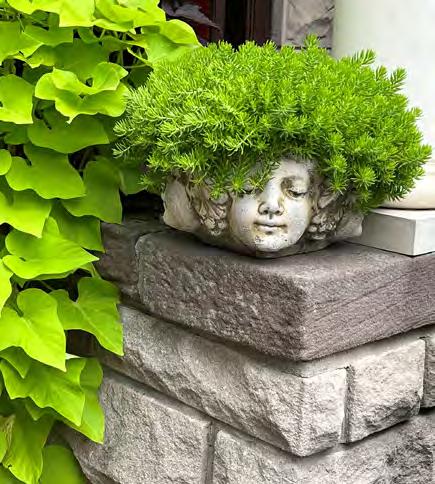

in what were then their country homes, to take advantage of the gorgeous prospects over Grenadier Pond, the Humber River and Lake Ontario.
Some 25 gardens ranging in size from tiny cottage-style gems to palatial estates will be on view; many backing onto woodland ravines, resting on the shores of Catfish or Grenadier Ponds, some with priceless settings overlooking High Park.
Garden styles range from classical to modern. Many dedicated gardeners live here and some gardens ooze personality with intriguing plant combinations and whimsical garden art. The challenge of uneven grounds in some properties has been resolved with multi-levelled and tiered backyards, terraces and patios.
Many native trees, shrubs and plants have been retained or reintroduced. There are several pollinator-friendly yards and lots of wildlife in the area including turtles,



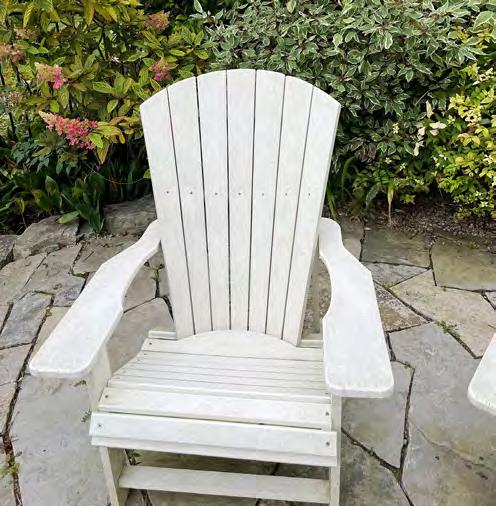
beavers, herons, osprey, ducks, swans and more. Many of today’s homeowners embrace ravine stewardship working to help restore and conserve the health of fragile ecological systems.
Thanks to the tour’s self-guided format, you can discover each garden at your own pace with a map and a guide that describes the features of each unique garden. a complimentary shuttle bus service allows you to “hop on and hop off” along the route. Back by popular demand, there will be live music in one or more of the gardens. Knowledgeable TBG volunteers and Toronto Master Gardeners will be in each garden, ready to answer any of your plant or garden design questions.
Through the Garden Gate annual garden tour, held in a different part of the city each year, is one of the TBG’s major fund raisers. For ticket information go to https://torontobotanicalgarden.ca
Tafelmusik at the Garden: Divertimento
From the Italian divertire “to amuse” this light-hearted music was frequently played at social functions, bringing people together to delight and revel in the antics of the performers.
Sunday, March 17, 2 p.m.
Public $25, TBG Members $23
Garden Shop Hellebore Sale
Back by popular demand, beautiful varieties of Hellebores are available for pre-order through our online Garden Shop. Plants will also be available for purchase on the day of the sale. Quantities are limited so shop early for the best selection.
Saturday, April 6, 9 a.m. to 4:30 p.m. Pre-order pick up and onsite purchase.

Toronto Botanical Garden Spring Plant Sale
Filled with a thoughtful selection of topperforming and ethically sourced plants from reliable growers. Enjoy a friendly and relaxed shopping experience surrounded by plants and the people who care for them.
Members Presale, Friday, May 10
Open to the Public on the Weekend
Saturday and Sunday, May 11 & 12
Through the Garden Gate: Swansea
TBG’s annual walking tour of Toronto’s most beautiful private gardens in the west-end Toronto neighbourhood of Swansea, which has properties bordering Grenadier Pond and the Humber River.
Saturday, June 8 & Sunday, June 9 11 a.m. to 4 p.m.
One-day Pass: Public $45, Members $40
Two-day Pass: Public $65, Members $60
Toronto Botanical Garden Annual General Meeting
Current members are welcome to attend the Garden’s annual meeting to learn more about last year’s achievements and help shape future developments.
Thursday, June 20, 6 p.m.
Tafelmusik in the Garden:
Sunday, June 30, 2 p.m.
Edwards Summer Music Series
FREE outdoor concerts showcasing contemporary Canadian talent, within the beauty of the Garden. Generously supported by the Edwards Charitable Foundation.
Thursdays nights at 7 p.m.
July 11 through August 29
torontobotanicalgarden.ca/event
What does sustainability mean? To Anela and Lilliana Dujsic, owners of LI/NE Bags, it means much more than just reusing items.
It means giving new life to items that would otherwise be thrown away. Through their apparel brand LI/NE the mother-daughter team has created a product that saves old sails from landfills and repurposes them into new bags for someone to love. From a sail used on a ship to a brand-new handcrafted bag, each LI/NE bag is unique taking on its own personality from the sail it was made from. Yet what every bag has in common is the care and attention to detail that can easily be seen and understood by using one yourself.
But what inspired them to create their brand? While Anela has an extensive history in both business and fashion, having worked with some of the leading companies in sustainability, that’s not where the LI/NE story begins. This is a family business and their eye for fashion and design has been passed down for generations. Anela’s grandfather was a leather glove maker in his day. His knowledge was passed down to his daughter Lilliana, cofounder of LI/NE in partnership with her daughter Anela. This family’s attention to detail, craftsmanship and style can be seen in each of their pieces. Everything down to the name of the brand itself, a mix of their initials, shows the care, love and purpose put into every bag.
From creating together for fun during Anela’s childhood, to founding a business together, the idea of making bags from sails stems from Anela’s sailing lessons, where her attention kept getting stolen by the




sails and what an amazing material they were made of — light, durable, resistant and still beautiful. She asked what happens to these sails as they age, and learned that once they cannot be patched anymore, they go into landfill. So, she asked if she could have one and took it home. And there she created the first LI/ NE duffle bag for herself.
Originally this water-resistant bag was only to be used for her own sailing lessons. But she soon found that she couldn’t use the bag without people asking where it was from, or if they could get one as well. And that’s how the company started.
From creating bags for friends and family to traveling to collect used sails all over Ontario, this mother and daughter duo has created a brand that not only prioritizes eco-friendly sourcing and expert crafting abilities, but fashion appeal, as well.
There are other companies that make items from discarded sails but what sets LI/NE apart is the craftsmanship and style in each bag. With a careful hand and an eye for perfection, LI/NE has created timeless pieces, because as Anela says, “sustainability can only be sustainable if it is used often, season after season, event to event”. This is why each bag is not only made to have a classic appearance that can be used in multiple settings, but the stitching and materials used are meant to last just as long.
Come into the TBG Garden Shop this April to try a LI/NE bag for yourself and see just what makes them so special.
TBG’ S vo L un T eer popu LAT ion i S G rowin G ! And TBG needs the help in order to meet the challenges of all the new and/or returning events, activities and programs as well as maintaining our gardens and running our yearround services.
While the stalwart crew of volunteers who got us through the pandemic years will forever have a special place in our hearts, we are delighted to be growing again and hope that, for our new volunteers, this is the beginning of a long and fun connection with TBG.
Having ended 2022 with 196 volunteers we saw out 2023 with just over 300! While still not at prepandemic levels this volunteer team has more than met the demands of a very busy year in the Garden.

◗ MiriaM Wong • Reception Miriam joined us in April, 2023 and was one of the first members of TBG’s newly formed reception team. If you visited TBG on a Saturday last year chances are you will have been greeted by Miriam, who has so ably looked after 22 shifts at our reception desk thus far.
With a background in quality assurance in the pharmaceutical industry and previous volunteer experience at various musical and sporting charity events (including organizing golf tournaments) Miriam took no time at all to fit right into the reception role and we are so glad she plans to continue being the “face of TBG” into 2024.

◗ Tanya OnieOgOu • Tour guide
Tanya joined TBG in April, 2023, dove straight into tour guide training and went on to lead 19 tours last year! Tanya showed her versatility in this endeavour being one of the few tour guides who led both TBG/Edwards Gardens tours and ravine tours. An individual of many talents, Tanya has a deep passion for gardening. She is also an avid photographer, a long-time visitor to Edwards Gardens and has previous volunteer experience at a seniors’ centre. This diverse background has resulted in a great match with the role of tour guide and we are delighted that Tanya plans to continue leading tours for TBG while pursuing her dream of becoming a Master Gardener.
These two lovely ladies are typical of the wonderful talent base TBG enjoys in its volunteer population. We are in a good place to tackle all that 2024 has in store!


Classi C al labyrinths have been in existence since very early times. Depictions of labyrinths have been found in ancient Crete, Egypt, Rome and many other parts of the ancient world such as in India and the Americas. Labyrinths appear as designs on pottery and basketry and in etchings on walls of caves and places of worship.
It is fairly common to find mosaics depicting labyrinths during the Roman Empire.
The House of the Labyrinth, one of Pompeii’s most famous dwellings from the 2nd century BCE, derives its


the Van dusen maze in Vancouver has 3,000 Pyramidal arborvitae, planted in 1981. there is an observation terrace from which the less adventuresome visitor can view the maze.
Photo: Wikipedia

name from the oldest known Roman labyrinth mosaic, with Theseus defeating the Minotaur as the central image.
Labyrinth and maze are sometimes used interchangeably, however, although both may depict a complex and confusing series of pathways, the two differ fundamentally in design and intent. A labyrinth has only a single, non-branching path, and is easy to follow, leading to the centre, which often becomes a means for a spiritual or contemplative journey. A maze is a complex, branching puzzle that includes choices of path and direction, and sometimes frustrating dead ends, and is intended for fun and amusement.
the following books from the Weston Family Library will provide more in-depth information about the history of labyrinths and mazes.
1 ◗ Magical Paths: Labyrinths and Mazes in the 21st Century by Jeff Saward call number: Sb475.Saw 2002
2 ◗ Labyrinth: Solving the Riddle of the Maze by adrian Fisher & georg gerster call number: Sb475 .Fis 1990
3 ◗ Mazes and Labyrinths: Their History and Development by W h. Matthews call number: Sb475 .Mat 1970
Labyrinths and mazes have been constructed out of simple materials such as paving stones and bricks but often using natural materials in fields or gardens such as hedges, turf, corn stalks, or straw bales. During the medieval period, labyrinths found their way into the gardens of the nobility and there is evidence that these designs transformed into puzzle mazes made of hedges. There are many famous formal landscaping mazes located across the world from the last few hundred years. In recent times, mazes made using crops can be very large but tend to last only a single growing season, so they can be

different every year and are promoted as seasonal tourist attractions.
Labyrinths have experienced a resurgence of interest as a vehicle to establish a reconnection between human beings and nature. The act of traversing a labyrinth, with its archetypal patterns found in nature –the spiral and the circle – facilitates healing and wellbeing and increases the connection with our spiritual or psychic selves and the natural environment. Researchers at Harvard Medical School have found that walking a labyrinth can lower the breathing rate, blood pressure and reduce chronic pain as well as stress levels and anxiety. They are being built at hospitals, churches, wellness centres, playgrounds and prisons.
The Labyrinth Community Network of Ontario has put together a listing of Labyrinths in Ontario http://www.labyrinthnetwork.ca/ ontario-labyrinth-directory. Find your local labyrinth and go for a walk!


were even depicted on Greek coins dating back to the 3rd Century. this one, minted in Knossos, Crete, has the labyrinth on one side and the Goddess Hera on the other: Photos: art institute of Chicago. Middle left: 3. this extensive labyrinth is made from lavender plants at Cherry Point farms in shelby, Michigan. Photo: Cherry Point Farm and Market. Middle right: 4. this classic design from the 12th Century is located on the floor of Chartres Cathedral, France. Bottom left: 5. Man in the Maze or i’itoi (pronounced ee-toy) is a sacred symbol of the tohono o’odham sonoran desert people of the american southwest. it symbolizes the journey through the maze of life. the basket is made from willow shoots, cattails and devil’s claw. Photo: Bowers Museum, santa Clara, California, Bottom right: 6.







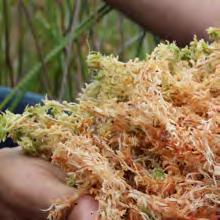
to use or not to use as a soil amendment? alternatives offer a solution
By Jean McCluskeyAs my North y ork g A rde N h A s he Avy cl Ay, I h Ave ofte N bought b A gs of pe At moss to A me N d I t.
h owever, the A rt I cle For Peat’s s ake IN o n n ature
m A g A z IN e, s pr IN g 2023 m A de me th IN k A g AIN .
Peatlands, which take thousands of years to form, store twice as much carbon as the world’s forests.
“Canada’s peatlands store some 150 billion tonnes of carbon. That is equivalent to 25 years’ worth of the country’s greenhouse gas emissions,” writes journalist Jade Prévost-Manuel.
Not only does peat mining release masses of carbon into the atmosphere but it may also cause flooding and water contamination. Because peatlands soak up and filter so much water, they protect areas from flooding and provide safe drinking water.
Dr. Michelle Kalamandeen, a climate change researcher at McMaster University says in the article “Canada’s peatlands have a huge role to play (in addressing climate change). By draining the peatlands, by getting the sphagnum moss into gardens you’re damaging an entire ecosystem for something that there are alternatives for.”
So, what are the alternatives?
The best alternative is homemade compost (grass clippings, disposable plant material, kitchen scraps). It should be kept moist and turned occasionally. Adding some old compost will give the new
bin organisms that help it to work. Raked up and mowed-over leaves will form leaf mould.
Soil can be improved by adding animal manure, worm castings and a good quality mulch, such as wood chips, wood shavings or pine bark, which applied in the spring and fall will improve the texture and add nutrients.
Another alternative is coir (a fibre obtained from discarded coconut husks) which can be purchased in pressed blocks. These expand and soften up when water is added. Although no ecological damage is done when it is harvested, however, there is the cost of having it shipped here.
Perlite, rice husks (hulls removed from rice grains during the milling process), bentonite clay (for sandy soils) and sand can all help plants to thrive by loosening the soil and improving drainage.
It is also important to check soil mixes as even those labelled “organic” or “environmentally friendly” may still contain peat.
By using these alternatives rather than peat products gardeners can help save the planet for generations to come.

We’re learning to garden differently, using more native plants, banishing pesticides and being wary about practices that release greenhouse gases into the atmosphere. As a part of this, many countries are taking a serious look at the use of peat moss as a soil amendment.
Peat moss is a big business in Canada, because one third of the world’s peatlands are located here, covering about 14 per cent of our territory, mostly in boreal (Yukon and northern British Columbia to Newfoundland and Labrador) subarctic and arctic areas.
In 2021, we exported $574 million dollars worth of peat, mostly to the United States.
When we talk about peatlands, we mean peat bogs or wetlands. Fens, as they’re called in England, are a favourite location of British mystery writers; their haunting settings are perfect as a place for a variety of dastardly deeds. Whatever you call them, there are two key products that are harvested from bogs –sphagnum moss, which is the living material floating on the surface of bogs, and peat moss, which is decomposed sphagnum moss that has been steeping in bogs for thousands of years. It is sold as a soil additive and is also an ingredient in any number of commercial horticultural products.
Using peat moss in your soil has a number of advantages: • It absorbs and retains water, preventing soil compaction.
• It gives a big boost to acid loving plants, although it isn’t particularly good for plants that need an alkaline soil.
• It is pure – containing no fungi or bacteria.
• It doesn’t add any nutrients to the soil, but it does help to preserve the nutrients that are already there.
The problem isn’t using peat moss in your garden; the problem is what happens when it’s harvested. Peat bogs are great when they’re undamaged, because they hold a huge amount of carbon in their soil – twice as much as can be found in the world’s forests. That carbon is safe from release into the atmosphere, until harvesting takes place. Then, an enormous amount of carbon dioxide is released into the atmosphere, and carbon dioxide is one of the biggest of the greenhouse gases that lead to global warming.
Moreover, peatlands are the habitat of many kinds of wildlife as well as of many pollinator plants. Numerous
species of birds, butterflies, amphibians and larger wildlife such as hares, muskrats, beavers and caribou make their homes around wetlands. When the bogs are harvested, the habitat is destroyed.
Because of this, some countries have taken dramatic action. In 2019, Ireland banned commercial peat harvesting. In England and Wales, in 2024, sales of peat to home gardeners will be banned. Will that happen in Canada? Not so far.
The Federal Policy on Wetland Conservation was released in March 1992, under Canada’s Green Plan. But, over 30 years ago, very little was known about climate change. It is mentioned only twice in the report, as something that should be researched. The policy focuses on the conservation and restoration of wetlands as well as concerns regarding biodiversity (conserving habitats). However, Environment and Climate Change Canada has released its 2030 Emissions Reduction Plan that does focus on peatlands and their carbon emissions. Justina Ray, President and Senior Scientist of Wildlife Conservation Society Canada, says: “Peatlands are one of the greatest carbon capture systems on Earth. If we want to fight climate change, keeping Canada’s iconic peaty landscapes intact is essential, for all our futures.”
The Canadian Peat Moss Association says that its mission is “to promote the sustainable management of both the industry and the Canadian peatlands.” Their restoration objective includes the reintroduction of peatland plant species as well as to rewetting the peatland. All of this, they say, is a multi-year project. Many environmentalists claim that to actually restore a peatland takes over 100 years.
Although all parties focus on the importance of restoring peat and related vegetation, the fact is as long as the harvesting continues, there will be the problems of habitat destruction and carbon release to deal with. Considering how much peat we have and how lucrative it is, I don’t think we can expect big business to fall on their swords and stop harvesting voluntarily. It will take either a very powerful environmentalists’ lobby or a stronger commitment by the government to make something happen.
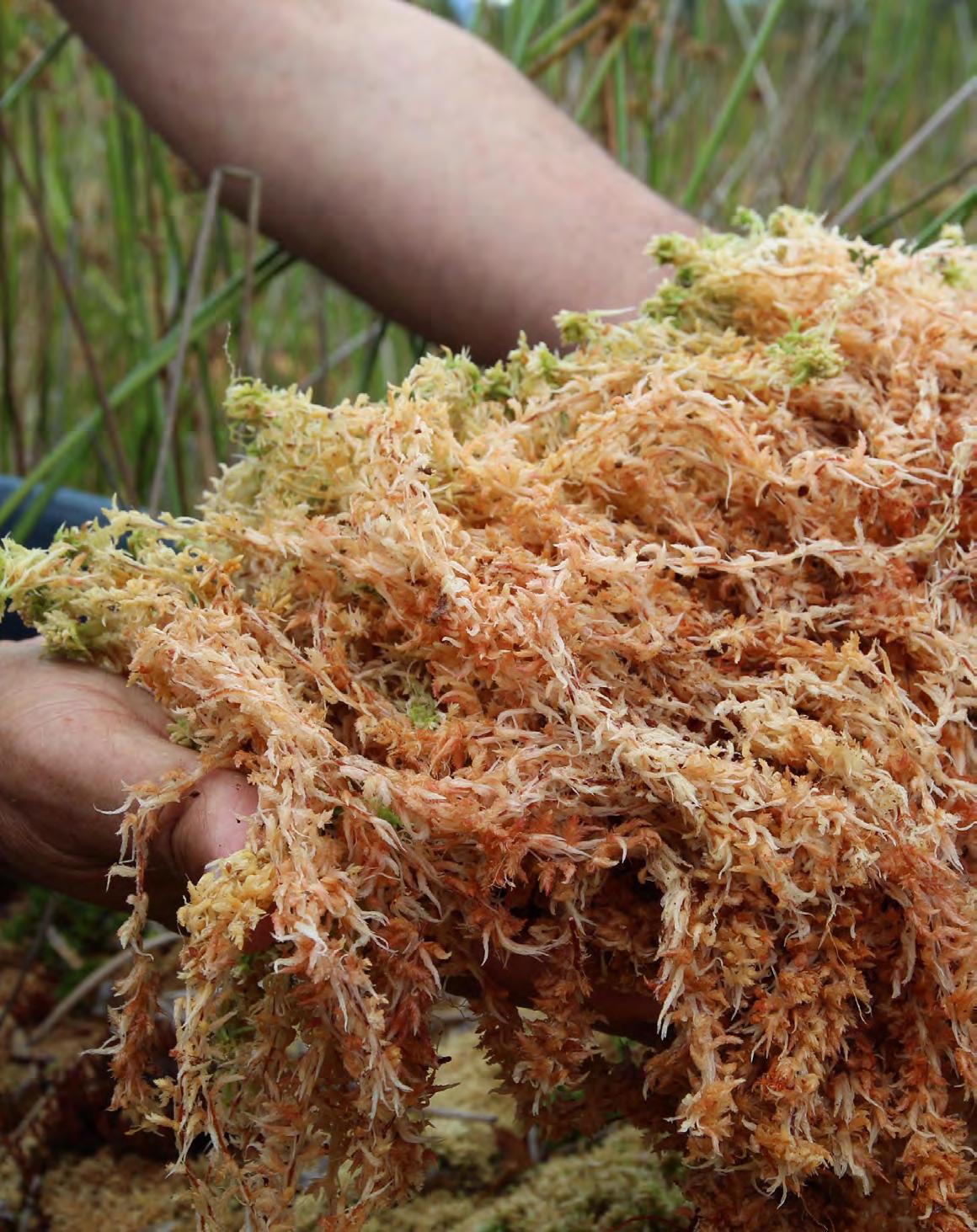

An ensemble cast in a play that changes year after year
Story and photos by Sasan Beni of
Hope is tHe tHing witH featHers
Hope is the thing with feathers that perches in the soul, And sings the tune without the words, And never stops at all.
And sweetest in the gale is heard; And sore must be the storm, that could abash the little bird that kept so many warm.
i’ve heard it in the chillest land And on the strangest Sea; Yet never in extremity, it asked a crumb of me.
- Emily Dickinson
Ihave loved this poem for many years. I recite it often when hiking on trails and breaking bread with my solitude in old growth forests. Perhaps it appeals to me as a birdwatcher. It’s likely that Dickinson had me at “the thing with feathers”.
As a horticulturist, I’ve learned that gardening in itself is an act of hope. And we are a hope-dependent species. We need to look forward to things. It is no wonder that this poem is always at the forefront of my mind, easily accessed by the tip of tongue during the winter months. I tell myself that she was writing about spring, longing for spring, the season of hope, our communal dream. We look for signs that it’s on its way. We need assurances that it hasn’t forgotten about us.
The truth is, all seasons have harbingers – species that signal the shifting tides of daylight, the creeping cold – but none of us are actively seeking out these messengers and taking their songs to heart in the summer and fall when we are lost in the blooms and the lush. And by mid-winter, most of us are fidgety and restless like rush-hour commuters at the station, leaning sideways


and peeking down dark subway tunnels, waiting for the next train to light up the tracks.
Recently, I had some time on my hands, so I set out to determine who is the real harbinger of spring? To whom do I owe a debt of gratitude for reminding me of the warm glow at the end of the tunnel, my waking garden?
I’ll tell you now, there is no clear winner. The harbingers of spring are an ensemble cast in a play that changes year after year, as do I, as does the garden...
Listen for the red-winged blackbird, often the first migratory bird to return to its breeding grounds. When I hear them, I know that spring is right around the corner.
 Northern Cardinal
Northern Cardinal Female
Red-winged Blackbird
Northern Cardinal
Northern Cardinal Female
Red-winged Blackbird


Male blackbirds arrive before their mates, as if eager to bring us the news. They are loud, they are bold, they perch up high and let their presence be known.
Generally speaking, birds make for some of the best harbingers. Their songs are great indicators of change. Our beloved northern cardinals can be heard singing their mating calls in late February. And if you listen closely, on those sun-soaked days, you might hear the quintessential sweee-tie sweee-tie of black-capped chickadees in the woods. Hearing these changes in birdsong is like feeling the sun’s rays on your face after three months of overcast. I thank them for the messages every time.

And down by the creek, there are other signs, poking out of mud, out of vernal pools, frozen still. In late winter, Wilket Creek comes alive with skunk cabbage blooms. This distinct species, part of the arum family (Araceae), is the first to flower, and one of few plants that exhibit thermogenesis. At their peak, the spadix of these alien aroids can generate heat – about 20 degrees warmer than ambient air temperature – to melt the icy world around them, and remind me year after year that the impossible can happen.
Spring is here, and I’m ready to be lost again in the blooms and the lush.

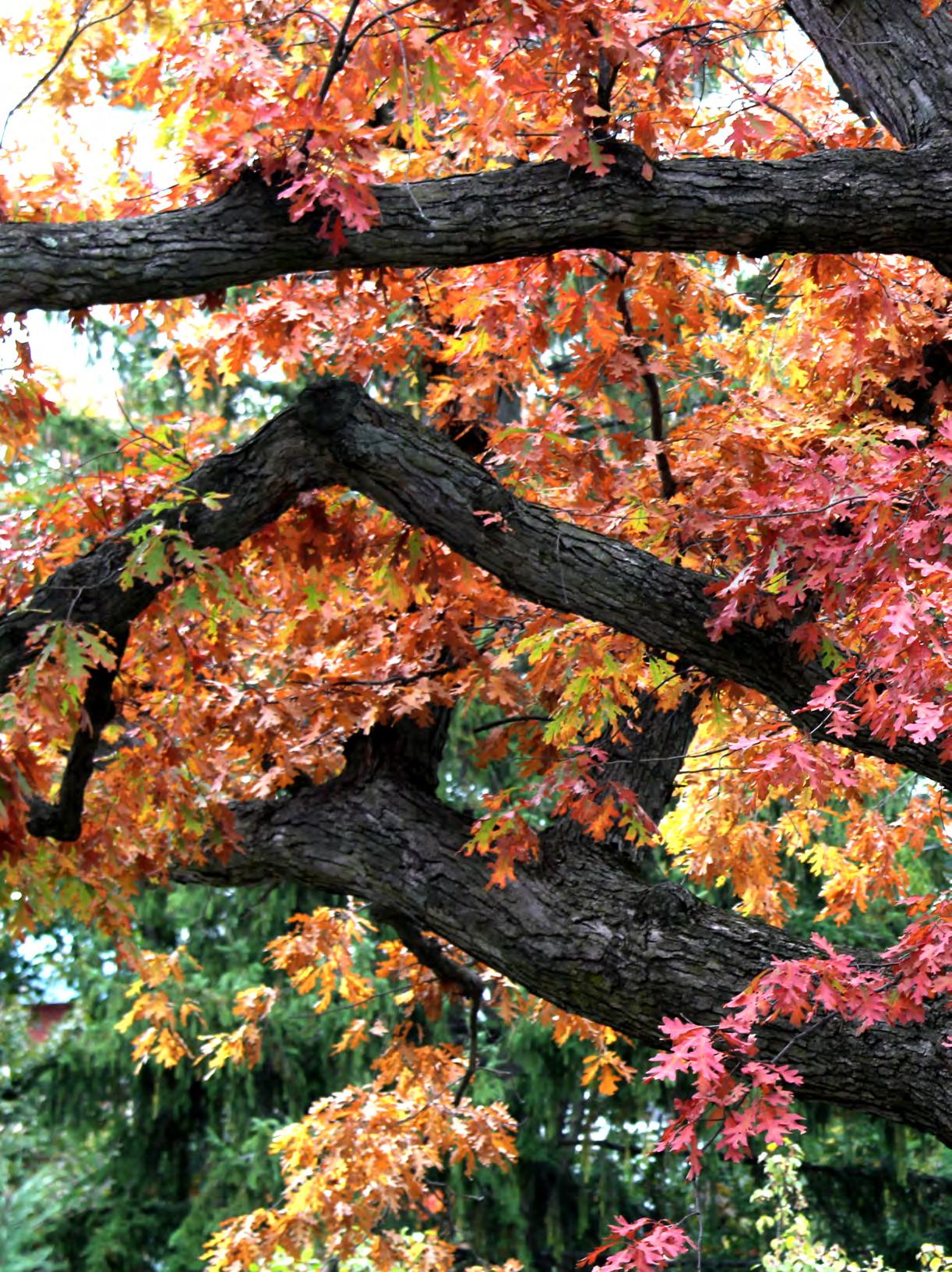 White Oak (Quercus alba)
White Oak (Quercus alba)

Trees at Mount Pleasant Cemetery have wondrous stories to tell
By Rose Roberts Photos by Janet DavisWHen i tell my friends that my favourite place to walk is Mount Pleasant Cemetery (MPC), their quizzical look is accompanied by the obvious Why? the short answer? the trees!

The spherical, spiky fruits referred to as gumbaLLs are a wonder T o behold
Nestled in the heart of Toronto, this 19th century cemetery and national historic site is more than a resting place for some of Canada’s most notable figures. History buffs can trace the city’s evolution. Walkers, runners and cyclists can take to its winding roadways. Birdwatchers and photographers can catch sight of natural treasures. And me? I come to be among the trees of the MPC arboretum – a gem hidden in plain sight and only minutes away from my home.
I’ve walked its paths for two decades, and yet, there are still so many more trees to learn about, to marvel at: yellow buckeye, cherry birch, Japanese larch, Babylonian willow, Swiss stone pine, persimmon and paw paw. Each season reveals its own beauty. Each visit deepens my appreciation and respect for these wonders of nature.
In 1873, landscape architect Henry Engelhardt was hired to transform an expansive farmer’s field into Mount Pleasant Cemetery. He envisioned a park-like setting and arboretum “for the enjoyment of the public.” Today, with more than 250 species of trees, the MPC arboretum is considered one of the finest in North America.
The collection is divided into two groups: native and exotic. Its specimens range from our native white oaks (Quercus alba) – many of which predate the cemetery’s opening in 1876, with the oldest estimated to be 250 years old – to the rare castor aralia (Kalopanax septemlobus), native to eastern Asia. This diversity has created a haven for wildlife and helps maintain a healthy ecosystem. These trees have stories to tell. They are stories of resilience, adaptation, risk and, sometimes, recovery. Let me introduce you to a few.
Last fall I attended a guided tree tour at MPC, led by Daniel Chevalier, MPC Group’s Arbor Services Coordinator. The 83-hectare (205-acre) cemetery, extending from Yonge Street to Bayview Avenue and divided by Mount Pleasant Road, provides a place for mature trees to flourish. As Daniel said, “The resultant microclimate created by the larger trees, enables trees that might be vulnerable or are far outside their growing zone to grow here.” Naturally, there is also loss. In 2023 about 20 mature trees were removed due to old age, disease or safety. “We do our best to replant them with a species that complements others in the collection,” he added.
if you’ve never been to the cemetery, a good place to start might be the area that Daniel aptly describes as a grove of wonders (west side; section V; the link for cemetery maps is at the end of this article). You’ll see a wide variety of trees all within 50 square metres. Here are a few favourites:
Shellbark Hickory (Carya laciniosa), an Ontario native, is very rare. Scattered specimens are found only in southwestern Ontario. It’s easily confused with the more widespread Shagbark Hickory (Carya ovata), found elsewhere in the arboretum. Shellbark is generally larger in size. Sweet Gum (Liquidambar styraciflua) is native to North America. These hardy trees have a high tolerance to salt and compaction, making them especially good city trees. The spherical, spiky fruits referred to as gumballs are a wonder to behold in every season. Although some consider the fruit messy, the seeds feed small animals. The maple-like leaves turn a gorgeous purple in autumn. In fact, I’d admired this tree from afar, thinking it was a maple. My
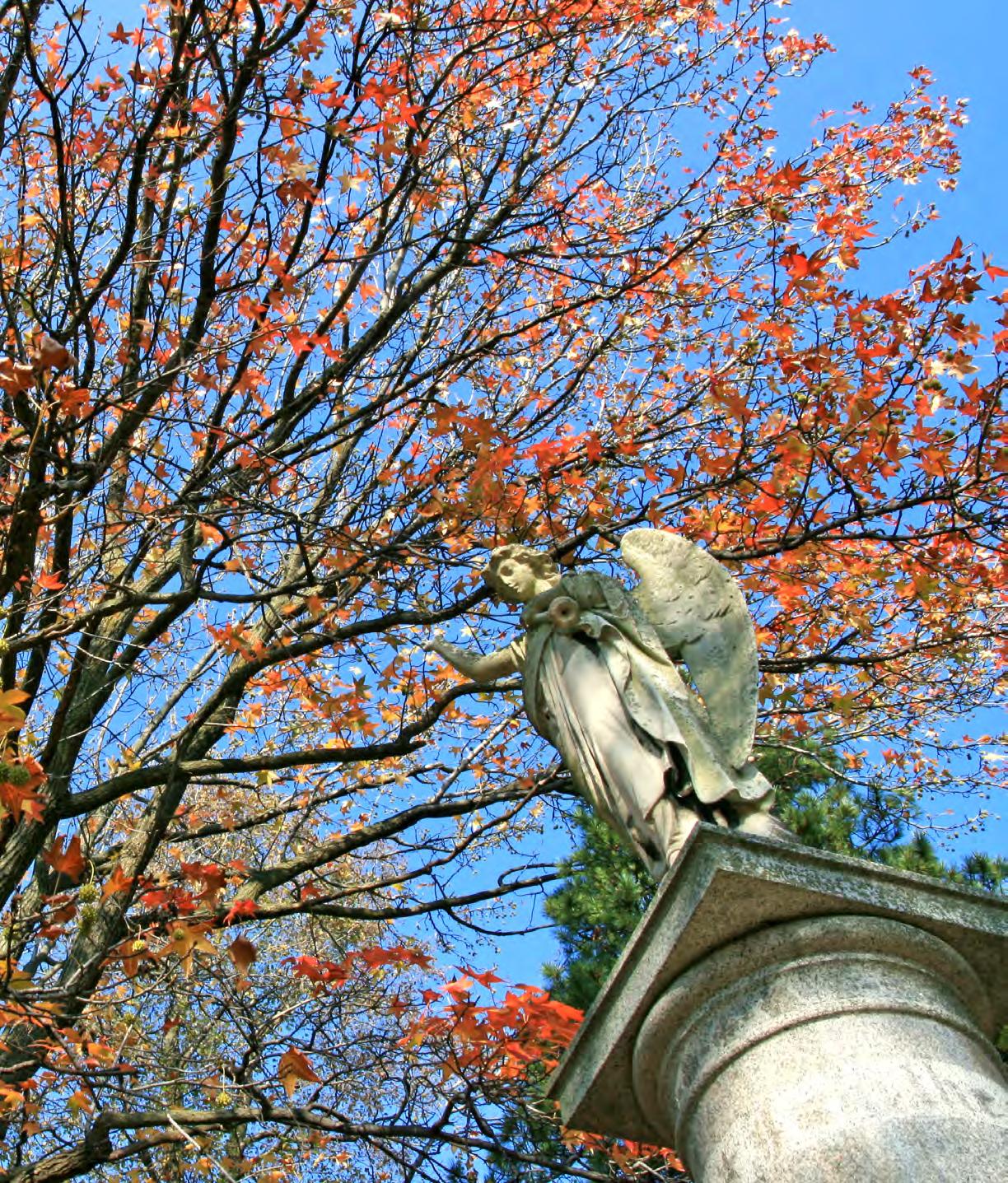
i’ve walKed iTs paThs for Two decades, and yeT, There are

sTill so many more Trees to Learn about, to marveL at
 Cherry Birch (Betula lenta)
Cherry Birch (Betula lenta)
They’re gorgeous buT are Typically borne high on the tree so be sure To looK up!
 Tulip Tree (Liriodendron tulipifera) Flower
Tulip Tree (Liriodendron tulipifera) Flower

lesson? Look closely; assume nothing! Castor Aralia ( k alopanax septemlobus) is a rare shade tree native to eastern Asia. Fierce-looking thorns cover the trunk and branches of young trees but become less prominent as the tree matures. Its flowers attract bees, and birds love its black fruits. It’s sometimes called castor oil tree, but don’t be fooled – it’s not the source of castor oil. Its leaves just happen to resemble the true castor oil plant, ricinus communis. Cucumber Tree (magnolia acuminata), Canada’s only native magnolia species and rare Carolinian species, is listed as endangered. It’s estimated that only 200 adult specimens are scattered across southwestern Ontario. The cucumber tree in this section stands 9 metres (30 ft) tall and is between 50- and 60-years-old. This late spring bloomer has unusual flowers – tulip-shaped, with yellow and green tepals that open vertically. The unripened, green fruit slightly resembles a cucumber, thus the name. It turns a lovely red when ripe, and its seeds attract small animals.
in other areas of the cemetery, both east and west sides, you’ll find additional members of the collection’s magnolia sub-group: The Tulip Tree (Liriodendron tulipifera L.), sometimes called tulip poplar, is neither tulip nor poplar! In fact, this striking Carolinian zone native is a member of the magnolia family (magnoliaceae). Its cup-shaped, yellow-green and orange flowers resemble tulips. They’re gorgeous but are typically borne high on the tree so be sure to look up! You’ll also find younger tulip trees in MPC that allow for a closer look. Their coneshaped fruits remain on the tree after the leaves fall, maintaining a tuliplike shape. This nectar-rich species attracts bees, ruby-throated hummingbirds and tiger swallowtail butterflies whose larvae feed on the leaves. The magnolia sub-group also includes the variegated-leafed cultivar l aureo-marginatum , ‘Majestic Beauty’ (located near the Yonge Street entrance) and the more familiar, equally beautiful Saucer ( m . x soulangeana ) and Star ( m . stellata ) magnolias.
The term living fossils, coined in 1859 by Charles Darwin, refers to an organism that has remained relatively unchanged over millions of years. These trees are testaments to
resilience, adaptability and the evolutionary process.
Ginkgo (ginkgo biloba), also known as maidenhair tree, is native to Asia and dates back about 150 million years ago. It was considered extinct until catalogued in the 1600s and is the sole surviving species of the gymnosperm family ginkgoaceae Today, this hardy species is very popular in urban settings. Lovely through spring and summer, it’s stunning in autumn when its unique fan-like leaves turn gold. Take note: Ginkgo is a dioecious species (separate male and female trees). The plum-like fruit borne on female trees has an unpleasant smell when ripe!
Dawn Redwood (metasequoia glyptostroboides) is a deciduous conifer once thought extinct until a small population was discovered in China in the 1940s. This survivor of the ice age has a remarkable history (history buffs may want to dig deeper!). Chinese botanists connected it to fossil records studied by a Japanese paleobotanist a few years earlier. Flash forward: Seeds were collected and sent to botanical gardens and arboreta worldwide. It eventually entered the nursery trade, becoming
 Ginkgo biloba with gold leaves in fall
Ginkgo biloba with gold leaves in fall
canada’s only naTive magnolia species and rare carolinian species, is Listed as endangered.
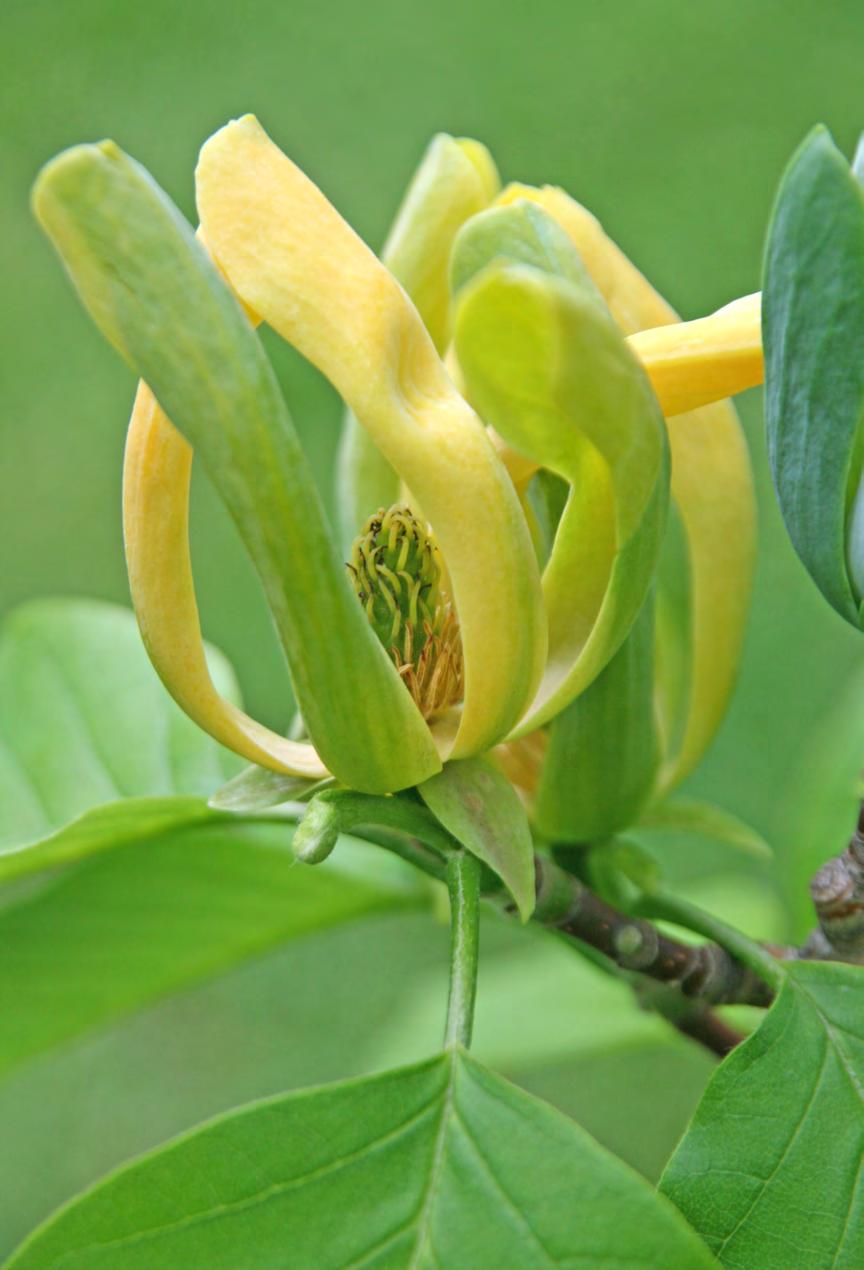 Cucumber Tree (Magnolia acuminata)
Cucumber Tree (Magnolia acuminata)

iT’s esTimaTed There are only one Thousand young ameriCan Chestnuts Left in ontario.
a widely used ornamental tree. To my eye, it’s most striking in autumn when its needle-like leaves turn orange just before dropping. The distinctive tapering trunk adds winter interest.
While reviewing several species at risk held in the arboretum’s collection, I was especially struck by the startling speed at which invasive pests and diseases spread. Here are two examples: Blue Ash (fraxinus quadrangulata), native to the Carolinian forest and once ubiquitous in Ontario, has suffered a significant decline. The primary cause? The invasive emerald ash borer (EAB) (agrilus planipennis). This wood-boring beetle, native to Asia, was introduced accidentally to North America in the late 1990s on wood packaging materials. Discovered in Ontario in 2002, it has killed an estimated 90 per cent of ash trees in the invaded areas across southern and central Ontario. While all North American ash species are vulnerable, studies indicate blue ash is somewhat more resistant to EAB than its counterparts. Slowing the spread of EAB is challenging, but MPC proactively
injects all their ash trees annually with an insecticide that goes directly into the vascular system of the trunk, which impacts only the inside of the tree. Blue ash is listed as threatened (special concern in Ontario). To the best of my knowledge, the full effects of the infestation, ecologically and economically, are still unknown. American Chestnut (Castanea dentata), a Carolinian species, is listed as endangered in Ontario. In the early 1900s American chestnut populations were decimated by the introduced chestnut blight (caused by the fungus cryphonectria parasitica). It killed 99 per cent of Ontario’s native chestnut population within three decades. Today, it’s reported that the few specimens sprouting from root crowns rarely exceed sapling size. It’s estimated there are only one thousand young American chestnuts left in Ontario. The tree in MPC is one of them.
I hope this glimpse of these complex and wondrous trees will inspire your own journey of discovery into the world of trees and the stories they tell.
While many of the MPC trees are labelled, the arboretum’s online booklet is a handy reference. It includes a selection of trees, with photos, locations, including key maps of the east and west sides of the cemetery: https://www.mountpleasantgroup.com/-/ media/Files/Brochures/mp-arboretum
r e F erences g ener AL : Filey, M. mount pleasant cemetery: an illustrated guide (Toronto: Dundurn Press, 1999)
https://arboretum.uoguelph.ca/ thingstosee/trees/cucumber
https://www.bellarmine.edu/faculty/ drobinson/sweetgum.a
https://www.ontario.ca/page/tree-atlas/ ontariosouthcentral
https://natural-resources.canada.ca/ our-natural-resources/forests/wildland
https://www.ontario.ca/page/ americanchestnut-species-risk
https://www.canada.ca/en/environment climate-change/services/species-risk
https://www.britannica.com/plant/ dawn-redwood
 Dawn Redwood (Metasequoia glyptostroboides)
Dawn Redwood (Metasequoia glyptostroboides)
Story and photos by
Leanne Burkholder
Irecently celebrated a ‘milestone’ birthday with a trip to Morocco. Of course, garden visits were on the itinerary, a fascinating way to understand a country like Morocco, with its diverse heritage, culture and geography. Gardens in Morocco, public or private, are essential spaces of respite. Influenced by Islamic design principles, they are often formal and symmetrical, integrated within a building, sheltered from the outside world. Elements include moving water for cooling and ambience, trees for
shade and food, flowers and herbs for scent. They are divided into quadrants that offer quiet places for socializing, eating or reflecting.
Frequently you will find personal touches with custom elements such as colourful ‘Zelliji’ tiles. These are hand cut and laid into intricate walkways in geometric patterns. There are also hand-carved wooden doors, arbours and fences, metal lanterns for light at night and potted plants. Many are hand-created by local artisans.


Riads are traditional Moroccan homes with an indoor courtyard garden. These are colourfully tiled and incorporate water features such as fountains surrounded by garden beds. Open to the sky, they attract birds thus adding song to the atmosphere.
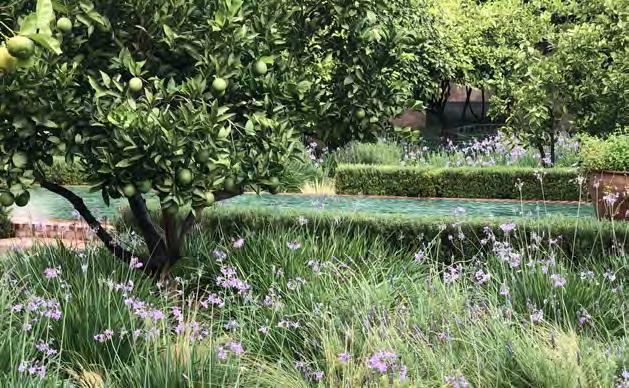
Located near the famous Jemaa el-Fnaa square, the Secret Garden is a renovated riad which opened in 2016. The site of a sultan’s palace in the 16th century, the garden is a simple, symmetrical design. It is bordered by high walls, centred by a pavilion with a fountain and benches. Colourful green and ochre tiles mark the paths in spaces divided by waterways. In fact, the Secret Garden is linked to an ancient irrigation system.
The planting is simple -– palm, olive and lemon trees as well as rosemary and lavender hedges. Agapanthus adds purple flowers and a mounded grass-like texture which softens the hardscape; firecracker plants provide strong pops of colour.

Top: Garden shelter with fountain. Left: Pathway with fig trees, agapanthus and rosemary hedge. above: Firecracker plants provide strong pops of colour.
 colourful Secret Garden has paths in spaces divided by waterways.
colourful Secret Garden has paths in spaces divided by waterways.
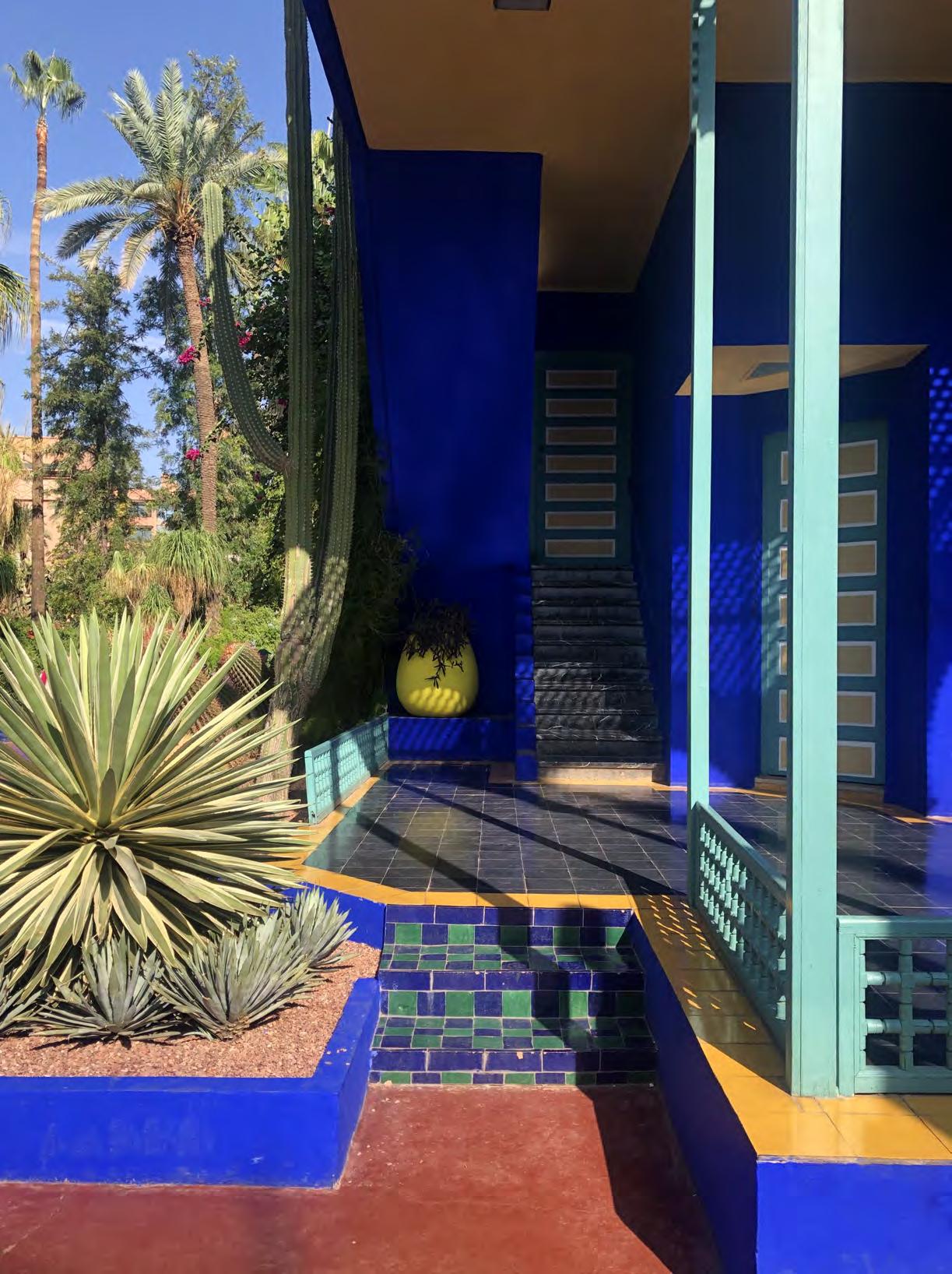
Stunning blues, yellows and greens at Majorelle are typical of the bold use of primary colours.

Majorelle
This is a stunning garden with bold use of primary colours to accentuate plants and spaces. French artist Jacques Majorelle, who bought the property in 1923, designed the garden and riad. Unfortunately, Majorelle could not keep up with the cost of the estate, and it fell into ruins until it was bought in 1980 by fashion designer Yves Saint Laurent and his partner Pierre Bergé who undertook to restore the riad and use it as a residence. The garden opened to the public in 2018; it is now run by a nonprofit foundation.
Majorelle collected more than 300 plants from around the world, including various palms and extensive types of cacti; Saint Laurent and Bergé added over 100 more to the collection. This garden is not symmetrical; its paths crisscross. It has water elements, pavilions and quiet seating areas.
The garden makes extensive use of bamboo – as a canopy and as thickets to divide spaces. Palms, fig and citrus trees add height; flowering vines, such as bougainvillaea and datura, feature on archways. Monstera is used throughout as a groundcover. A pomegranate hedge lines one of the walkways!



riad Le calife, Fez a small, owner-operated hotel with personal touches. riads are surprisingly quiet spots in bustling Moroccan cities.

Once fortified towns built originally for protection, Ksars (Kasbahs for royalty) are now private residences, hotels and historical or commercial areas. Today Ksars often have recreational areas including gardens.

Skoura o asis: Skoura is located within a historical date palm oasis which has existed since the 12th century. Today climate change poses a threat to these areas. Palm oases exist in valleys and lower areas near waterways and thrive due to access to water. However, today there are more drought challenges which affect not only vegetation, but human quality of life as well. In the past, groundwater could be accessed within four metres; now it is about 14 metres.
Upgrades such as drip irrigation are expensive to install. The lack of water has weakened date palms, making them more vulnerable to a fungus over the past few decades. Prescribed burns are used to limit spread of the fungus, but the loss of the trees has affected the livelihood of date farmers, and people are leaving the areas because agriculture is becoming too difficult.
Prescribed burns are used to limit the spread of fungus caused by drought challenges.

Public Gardens (Jnans)
r abat - Jardin d’ e ssais Botaniques de r abat : Run by the National Institute of Agricultural Research, this 17-hectare botanical garden is open to the public; it is used for conservation, biodiversity, and environmental education. The garden is home to over 650 ornamental and fruit species from Morocco and around the world.
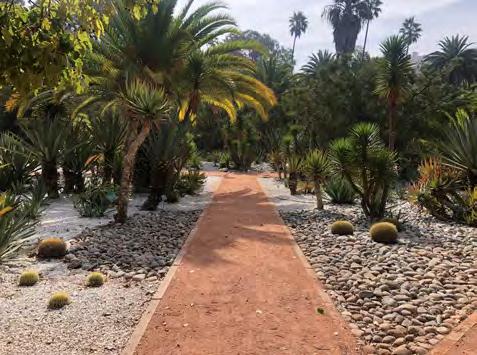

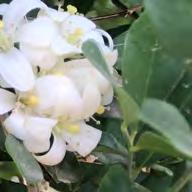





For more information check out these sites Moroccan Gardens https://www.visitmorocco.com/en/see-do/nature/discover-moroccan-gardens le Jardin Secret https://lejardinsecretmarrakech.com/en/ Jardin Majorelle https://www.jardinmajorelle.com/en/ Jardin d’essais botaniques https://www.visitrabat.com/en/lieux/jardin-dessais-botaniques/
Fez Jnan Sbil: Connected to the Royal Palace, these gardens were once the exclusive domain of royalty. They were opened to the public in 2011 and are one of the only green spaces in the old city of Fez. The park is connected to the ancient waterway system. Palm Walkway Bamboo Walkway Welcome bench surrounded by flowers. The gardens are connected to an ancient waterway.
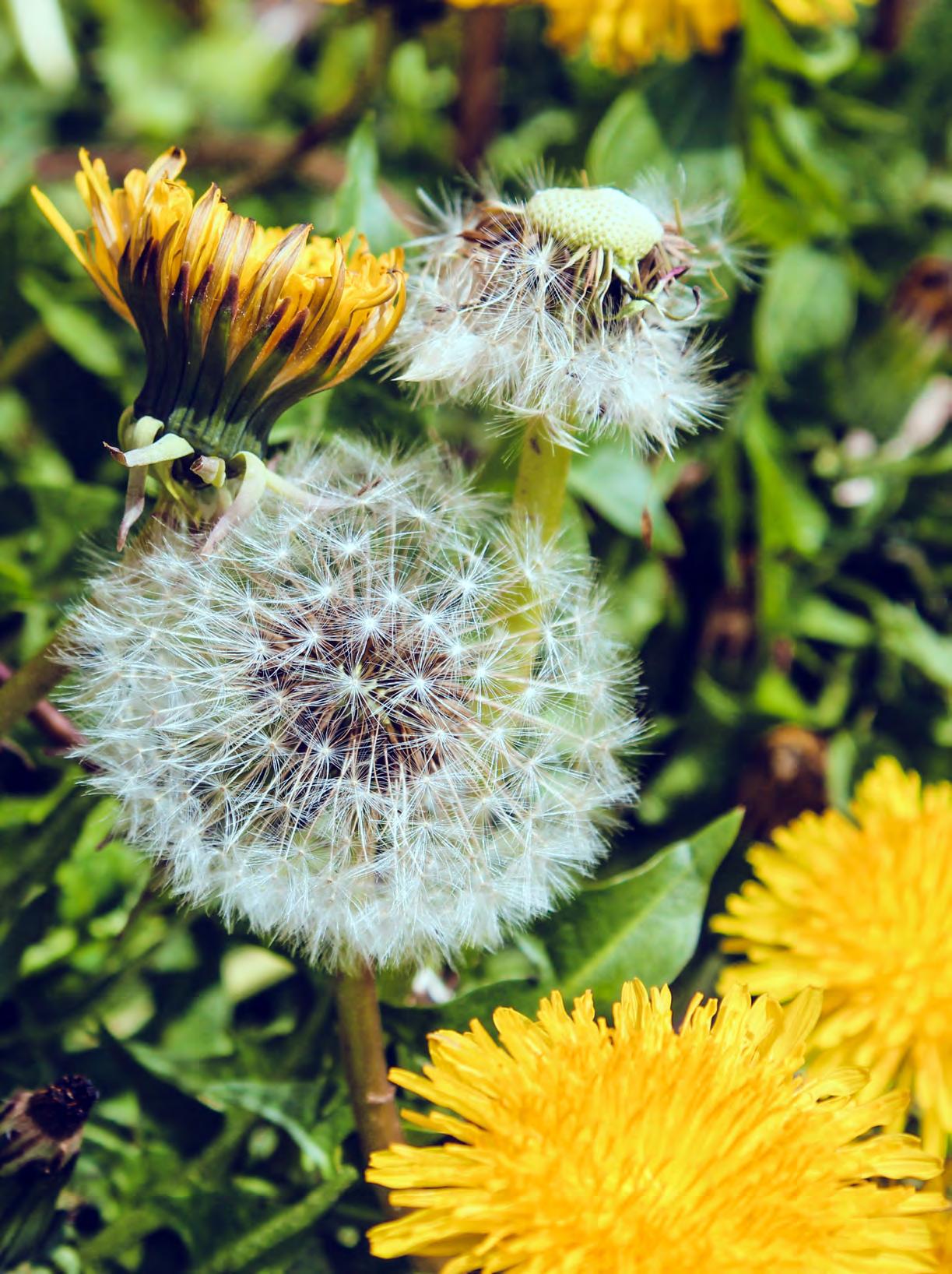
Dandelion dreams include visions of early pollinator food, sharp-tasting spring salad greens and wishes blown by hopeful children. Then those dreams and wishes transform your immaculate lawn into shameful wasteland with their denticulated leaf margins and never-ending taproots.
etymologically its english name derives from the French meaning ‘lion’s teeth’ whereas the botanical name originates in arabic tarashaquq meaning ‘bitter herb.’ Taraxacum officinale, family Asteraceae, the common dandelion is native to eurasia and thanks to human movement and perhaps a little to its wafting prowess, it is found worldwide. More often than not, despite its sunny beauty and ecological benefits, the dandelion is considered a weed.
What is a Weed? according to the Cambridge dictionary a weed is any wild plant that grows in an unwanted place, especially in a garden or field where it prevents the cultivated plants from growing freely. Wild here is used to refer to plants living and growing independently of people, in ‘natural’ conditions and with natural characteristics. increasingly, the value of wild plants is being understood and shared: now they are called native, indigenous and sometimes naturalized.
But how and who decides what is wanted and what is unwanted? i don’t consider the disruption of acres of homogenous lawn to be unpleasant, however, many do and wage war with Roundup, vinegar, spades or other tools against this much maligned plant.
dandelions are the most exquisite, early pollinator plant. the common dandelion inflorescence (dense cluster of flowers, resembling a single bloom) is yellow and its cousins range in colour from various hues of yellow to the spectrum of orange. these can be used as a pigment (yellow pancakes, yum) to make dandelion wine, or even a syrup resembling honey. dandelions open in the day and close at night. their hollow single stem exudes a milky latex when cut; a defense mechanism that only six per cent of temperate plants possess according to a 2017 McGill University study*1. this latex has even been used to make car tires! *2
Taraxacum are perennial herbaceous plants (they grow for years on end, with no woody stems) with an edible vigorous tap root up to 60 cm (2 ft) long! You’ll want to peel the root to remove much of the bitterness then you can eat it raw, boiled, mashed, fried, roasted and also,
as i’ve been told, grated which gives it a mild taste and a lovely crumb to a cake. this root, in addition to being tasty and nutritious, can develop into new plants if you leave any tissue behind. So it is important to pull up roots cleanly if you want to be entirely rid of the plant. On the other hand, if you’d like to grow a field of dandelions, scattered bits of roots would soon get you there.
it’s been a minute, but do you remember the drone show london had to welcome 2024? ahead of Big Ben chiming midnight there were, among other delights, dandelion pappus (tufts of hair) blowing the seeds away, a symbol of “the need to protect our natural world.” *3
dandelion seeds are remarkable, not only for making wishes, but they are produced by apomixis (asexually) and thus are essentially clones of themselves, but they can waft on the wind up to 800 km! in other dandelion drone news researchers, fascinated by this tiny seed’s long distance flight, are studying their flight patterns. Stealth drones have been modeled on these tiny seeds called, “one of nature’s best fliers”. long exposure photography and high speed imaging reveals a bubble like vortex around the seed that enables this remarkable long distance passive wafting flight. *4
Valued worldwide for centuries for their medicinal properties, culinary use and ecological importance, though dandelions may initially be perceived as weeds, these qualities make them valuable to both the environment and humans.
i’m eagerly awaiting early spring when i’ll sip dandelion wine, a 19th century curative for kidneys and livers. i’ll imagine myself to be in the company of hecate, the Greek goddess of the earth and the Underworld, eating a salad of dandelion greens as she did to honour theseus’ slaying of the Minotaur. it will be topped with shaved, roasted dandelion roots, accompanied by toast drizzled with dandelion ‘honey’ and decorated with dandelion capers. For dessert, i’ll have a dandelion cake with dandelion root tea, all the while marvelling at the early pollinators on cheerful yellow blooms and the lovely meal from this one weedy beauty. this could be the perfect welcome to spring ritual.
The common DanDelion is naTive To eurasia anD
Thanks To human movemenT anD perhaps a liTTle
To iTs prowess, iT is founD worlDwiDe.



Noxious weeds aren’t a matter of taste. they are difficult to manage, may reduce crop yield and quality, and negatively affect the health and well being of livestock and humans. examples of plants defined as noxious weeds in ontario include common barberry (Berberis vulgaris L.), european buckthorn (Rhamnus cathartica L.), poison ivy (Toxicodendron radicans (L.) Kuntze), and leafy Spurge (Euphorbia esula L.) learn more: noxious weeds in ontario | ontario.ca
3 tyPes of dANdelioN teA (from How to Make Dandelion Tea: 3 Types of Dandelion Tea - 2024Master c lass.)
1. Dandelion Root Tea, also known as roasted dandelion tea, dandelion coffee or dandelion root tea is made by roasting dandelion roots, steeping them in hot water and straining. Use a garden spade to harvest dandelion plants, leaving the large taproot in place. cut the taproot away from the rest of the plant and rinse it clean in cool water. Use a sharp knife to thinly slice the root. the root pieces should be roughly the same size as coffee beans. Spread the roots out in an even layer on a parchment-lined baking sheet and roast in a 350 degrees F oven for ten to 15 minutes. add dandelion root to a small saucepan of boiling water and boil for five to ten minutes. Strain through a fine-mesh strainer and serve.
2. Dandelion Leaf Tea: Making dandelion leaf tea involves very little prep time. Simply harvest six to eight
dandelion leaves from a young dandelion plant. thoroughly rinse the leaves under cool water and pat dry with paper towels. gently muddle the leaves in a mortar and pestle until fragrant. add leaves directly to the cup or place them inside a tea infuser. Steep in a cup of boiling water for five to ten minutes.
3. Dandelion Flower Tea is subtly sweet, and makes for a refreshing iced tea in the summertime. harvest about a litre of dandelion flowers. rinse them under cool water and gently pat dry with paper towels. boil one cup of water and place it in a large bowl. carefully add dandelion flowers and steep for five to ten minutes. transfer tea to a glass pitcher and refrigerate for four to 36 hours. add lemon juice or sweeteners, such as stevia, to bring out the sweet refreshing flavour of the tea.
forAge resPoNsiBly
dandelions are an early spring source of nectar for many beneficial insects including bees, so leave more than what you take.
*1 latex-emitting dandelions | office for Science and Society-Mcgill University
*2 continental constructing tires From dandelions | continental tire
*3 london rings in 2024 with Mayor’s biggest ever fireworks, lights and drone show over the river thames | london city hall
*4 Mystery of how a tiny dandelion seed can fly up to 500 miles is solved | daily Mail online
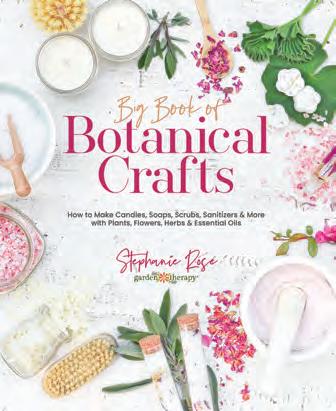
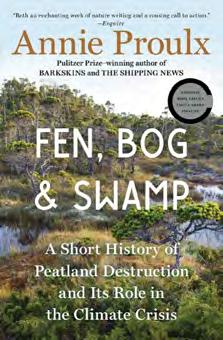

How to Make Candles, Soaps, Scrubs, Sanitizers & More with Plants, Flowers, Herbs & Essential Oils
Reviewed by Veronica Sliva
Author Stephanie Rose is a Canadian who lives in British Columbia and is well known for her popular website Garden Therapy (https://gardentherapy.ca/). Her website is full of articles and helpful tips on seasonal gardening, as well as recipes and instructions for gardeninspired crafts and décor.
Stephanie suffered from a debilitating condition for years. In her quest to eliminate harsh chemicals from her life she experimented with earth-friendly ingredients such as plant-based oils, waxes and other botanicals and discovered the healing power of plants on her path to wellness.
In The Big Book of Botanical Crafts she shares that she found solace and healing through gardening and herbs. She draws on her experiences from her personal journey and expert gardening knowledge.
Her book focuses on skincare and home-cleaning products with ingredients that are not harmful to us or the planet. She tells us that making our own products, besides being safe and not harmful to the environment, is an easy, restful and very creative way to help us slow down and reconnect with nature.
Divided into three sections, it includes “recipes” for 32 easy-to-follow projects: Home Apothecary, Soaps &
Sanitizers and Creative Candles. The instructions are thorough, easy to follow and accompanied by lovely photography. With lots of tips and ideas throughout the book, even beginners will find it easy to create any of the projects.
My favourite section is Home Apothecary. It is all about self-care concoctions with yummy names like Coffee Bean Massage Bars, Tub Tea, Lavender and Cocoa Butter Bath Melts and Peppermint Coconut Sugar Scrub to name a few.
This book is for anyone who wants to use effective products that don’t contain harmful chemicals. Gardeners, nature lovers and especially those with a creative streak


will find the projects in the book irresistible. Those who think they don’t have that creative instinct will be inspired to give it a go.
The Big Book of Botanical Crafts by Stephanie Rose (Better Day Books)
Reviewed by Jan Neuman
In Fen, Bog & Swamp, Pulitzer Prize winning author Annie Proulx draws our attention to the wetlands that are being destroyed around the world. During the pandemic, Proulx researched the destruction of the peatlands and what it means for the health of the environment and ultimately the future of all life on earth. Peatlands have great ecological value, supporting a large variety of wildlife. They also store huge amounts of carbon dioxide, and some peatlands, such as mangrove swamps, preventing shoreline erosion, while buffering land from storm surges.
Except for the chapter on the English fens, largely destroyed from the 16th century onwards, Proulx doesn’t spend too much time on ecology. Instead she investigates these environments in the context of their relationship to people. She draws on historical accounts, literature, art and archaeological digs. Fens, bogs and swamps are technically distinct, but they are also fluid; one wetland may
transition into another depending on its water source. This same fluidity is reflected in the book, where Proulx flits from one wetland to another, from one part of the world to another, from one millennium to another.
I found this approach fascinating, particularly her discussion of bog bodies. Thousands of well-preserved human bodies have turned up, especially in the bogs of NW Europe, the oldest dating back 8,000 years to the Mesolithic period. Most seem to have met their deaths through violence or as human sacrifices. The particular chemical composition of these wet areas affects different objects in different ways, but many of these bodies are still completely identifiable thousands of years after their deaths, including expressions on their faces, last meal, perfect hands and feet.
Proulx makes the argument that we are all complicit in the environmental destruction happening around us, “the awfulness of the present” as she puts it. It’s the belief of many in the world that creation is made for humans, meaning we can use the world as we wish. “The attitude of looking at nature solely as something to be exploited – without cooperative thanks or appeasing sacrifices – is ingrained in western cultures.” It’s this view of nature that means wetlands are drained to make land for farming and housing, releasing monumental amounts of carbon dioxide and methane into the atmosphere. What irony that destroying our historic wetlands is helping to cause global warming, which in turn is causing waters to rise and create more wetlands.
This is a detailed, fact-filled book that I will be thinking about for a long time. There are no answers here but many interesting details and past history and perhaps a few hopeful signs in the form of reclamation projects to restore some of the fens, bogs and swamps of the world before it is too late. Proulx isn’t confident: “The waters tremble at our chutzpah and it seems we will not change.”
Fen, Bog & Swamp, by Annie Proulx (Simon and Shuster)
Seed to Table
a Seasonal guide to Organically growing, Cooking and Preserving Food at Home Reviewed by lorraine hunter
luay Ghafari is an urban gardener, educator, consultant, recipe developer and founder of Urban Farm and Kitchen, a garden-to-table food blog. Taking a culinary program at George Brown College inspired him to focus on seasonality and self-sufficiency.
His book Seed to Table is filled with basic knowledge, growing techniques, garden planning and maintenance tips, as well as delicious recipes and preparation advice for anyone who is or wants to be an organic gardener.


Both a gardening and a cook book, it encourages readers to think about becoming more self-sufficient. The author recommends 21 easy to grow crops including cold weather vegetables like radishes, lettuce and carrots and warm weather ones like tomatoes, herbs and garlic and explains everything you need to know about growing them.
The book includes technical aspects of garden planning, growing techniques, fundamentals of soil health, seed starting, garden maintenance and more. QR codes lead to his website, the first one taking you right to a video of the author himself. This book is beautifully illustrated with mouth-watering photos of freshly picked tomatoes, beans and other vegetables and herbs as well as tasty looking home-cooked dishes.
Intriguing recipes like Risotto with Spring Greens and Asparagus or Sweet and Sour Roasted Carrots encourage readers to both enjoy and share their garden bounty. These include such garden-inspired libations as Thai Basil Smash and Strawberry Rhubarb Shrub (sipping vinegar). Salads run the gamut from Peach Panzanella-Style to Roasted Beet and Zucchini. And there are chapters on pickling and fermenting and herb blending.
Seed maintenance, pest identification and management, the importance of flowers in edible gardens and extending the growing season are all covered in some depth. There is both a complete glossary of gardening terms and a list of gardening resources.
Seed to Table by Luay Ghafari (Yellow Pear Press)





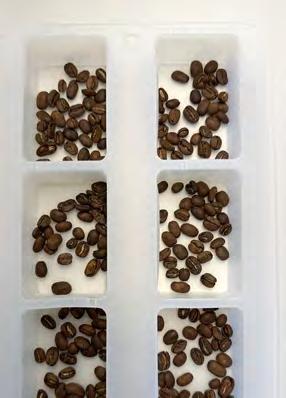
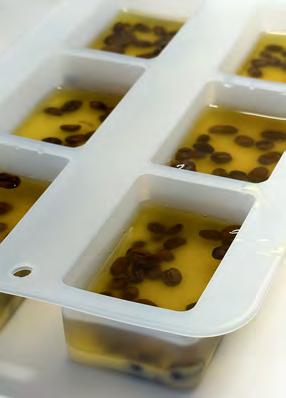
These bars smell delicious, with the coffee beans giving great texture as well as antioxidants that help calm inflammation. The nourishing ingredients melt into your skin, moisturizing and encouraging relaxation. You’ll end up with six massage bars, which is ideal for self-use and for sharing.
What you’ll need
• 3 oz beeswax
• 3 oz grapeseed oil
• 4 oz cocoa butter
• 6 tbsp roasted whole coffee beans
• Kitchen scale
• Double boiler with pouring spout
• Rectangular silicone soap mould

1. Weigh the beeswax, grapeseed oil and cocoa butter. Chop the beeswax and cocoa butter into small pieces and add them with the grapeseed oil to the top pot of a double boiler.
2. Add one tbsp of coffee beans to each cup in the silicone soap mould.
3. Add water to the bottom pot of the double boiler and adjust the heat to medium. Heat the ingredients in the top of the double boiler, stirring until they have all melted together. This should take about 15 minutes.
4. Pour the ingredients into the silicone mould, dividing the contents equally.
5. Leave the massage bars in a cool area, undisturbed until they are set. This should take one to two hours.
6. Pop the bars out of the mould and store them in the refrigerator when not in use.
Recipe inspired by the Big Book of Botanical Crafts by Stephanie Rose. See book review page 64.

Reviewed by Walter sliva
As a nature lover, I enjoy working on puzzles that depict beautiful gardens and wildlife. ‘Spring birdhouse’ is my kind of puzzle. The colours and details are clear and lifelike, with excellent contrast making each aspect jump off the page. The large size, 49 cm x 67.5 cm (19.25 X 26.6 in) of the puzzle and the inclusion of an exact photo of the finished work make it possible to locate each
piece in the photo, and then properly insert it where it belongs.
Most puzzlers will be familiar with the Cobble Hill Puzzle Company, from Victoria, BC. Their product is made in the US to museum quality standards, using the finest inks and varnish, linen textured paper and recycled chipboard. The pieces are random-shaped with no two alike, making them more interesting and challenging to assemble.
Assembling a 1,000-piece puzzle by Cobble Hill is a total pleasure.
The pictures are wonderful and the materials top quality. I find that smaller puzzles are finished too quickly, some of the pieces are too small to work with, and the picture is too small to appreciate the details.
The TBG Garden Shop sells Cobble Hill puzzles.
Reviewed by lila Yorke
This 500-piece jigsaw puzzle comes in its own matching canvas pouch, making it easy for taking on trips.
With a patterned moon in the middle of a dark sky and surrounded by white flowers of all kinds this 35.5 x 48 cm (14 x 19 in) is a painting by Katie Daisy, known for her lush illustrations inspired by nature.
Recommended for ages 9 and over Moon Flower was fairly easy and quick to put together, starting with dividing the flower pieces into individual piles. Even though most of the flowers were white, they featured different flowers, leaf shapes and colouring as the objects on the moon’s surface. There are actually two borders to complete: the rectangle on the outside and the rounded edges of the moon in the middle. Although not as challenging as some 1,000-piece puzzles, this one was more fun than frustrating to assemble.





Winter
More than 5,500 people attended the tbg’s first threeweekend winter festival, Winter blooms, supported by an experience ontario grant in november and december 2023.
Activities included:
• an expanded Holiday Market from three to six days (two weekends) held in partnership with For the love of Markets;
• an outdoor winter experience including a wood- burning firepit and new giant human-size terrarium
filled with tropical plants designed by our horticulture team;
• a three-day, ticketed Wonders of Winterland circus Show put on in partnership with artists’ play dance+circus Studio;
• a large-scale, suspended art installation on the second floor by local nature-based embroidery artist amanda Mccavour; expanded educational winter programming for all ages.
notably, the Winterland circus Show attracted a new and enthusiastic family-focused audience with 90 per cent of the tickets purchased by the public, including families. one of the most popular scenes in this immersive show was an indoor snowball fight.







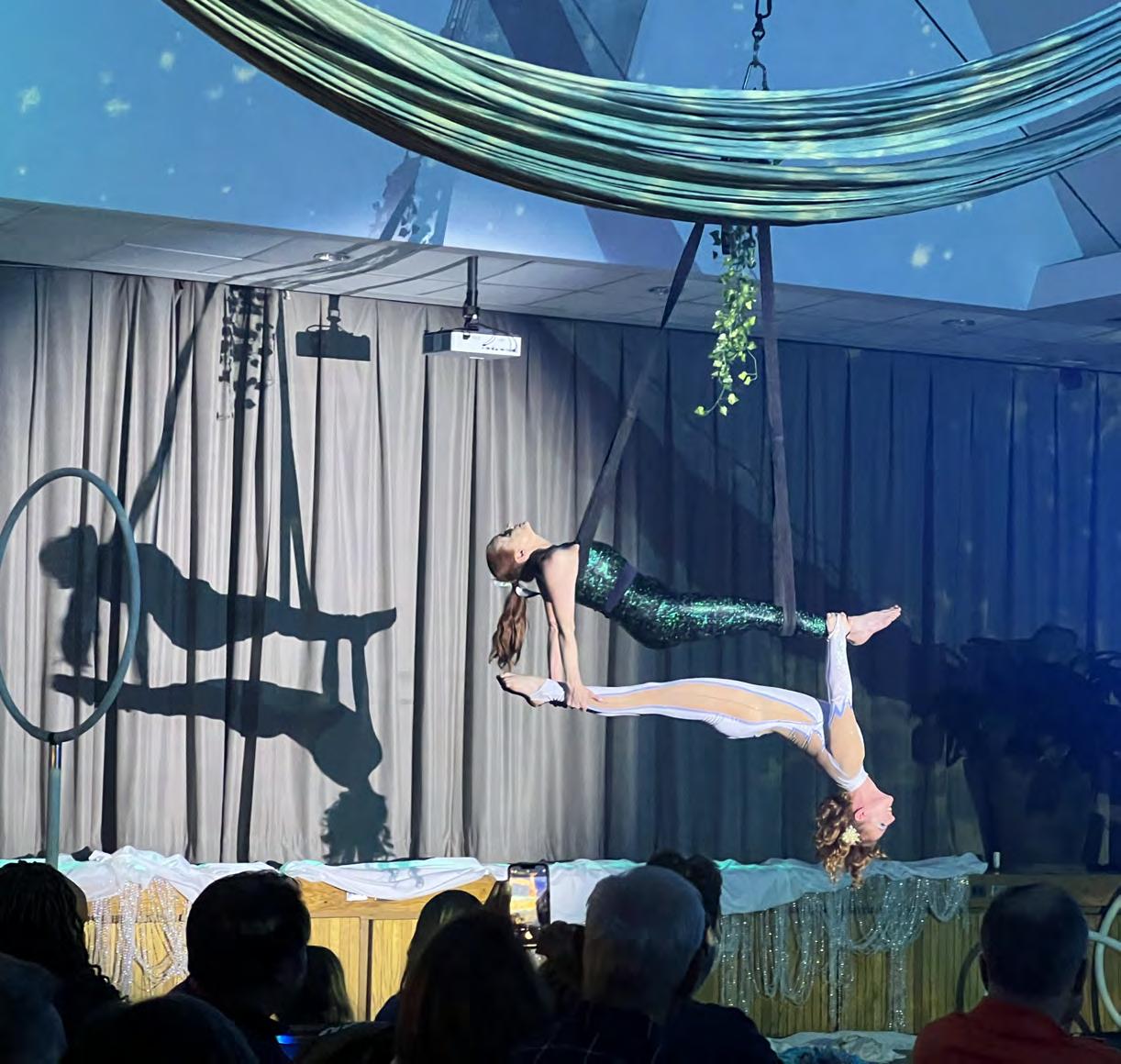

Garden
Gordon Ashworth, b oard Chair
Barb Anie, Dianne Azzarello, Adeline Cheng, Doris Chee, Michele Chandler, Ben Cullen, Tony DiGiovanni, Lisa Ellis, Susan Grundy, Abdullah Hamidi, Margareth Lobo Gault, Haig Seferian, Martin Ship, Janice Winton
e x o fficios: Derryn Gill (Garden Club of Toronto), Christina Iacovino (City of Toronto)
ExECuTIvE DIRECTOR
Stephanie Jutila sjutila@torontobotanicalgarden.ca
EDuCATIOn 416-397-1355 education@torontobotanicalgarden.ca
EdiTOr
lorrAINE HuNtEr
dESiGn
JuNE ANdErsoN
TrElliS COMMiTTEE
lEANNE BurkHoldEr suE HIlls
DEvELOpmEnT 416-397-1372 development@torontobotanicalgarden.ca
Your support and engagement are essential in developing an inspired plant place, an engaging learning environment, and a dynamic community hub. We invite you to grow with us.
mission
Toronto Botanical Garden connects people and plants, fostering sustainable communities and developing reciprocal relationships with nature through lifelong learning.
V ision
Toronto Botanical Garden is a garden for all; a diverse community that recognizes the life-giving role of nature, working together for a more sustainable world.
Receive the latest horticultural news and information on events, workshops, lectures and other horticultural happenings. Free registration at https://torontobotanicalgarden.ca
Visitor Centre: Open daily, 9 a.m. to 4:30 p.m.
Garden shop: Open daily, 10:30 a.m. to 4:30 p.m.
Weston Family library: Weekdays, 10:30 a.m. to 4:30 p.m. Weekends, 12 to 4 p.m.
note: The Visitor Centre, Garden Shop and Weston Family Library are closed on Mondays until the end of March.
tbG bloom CaFÉ: (located in the historic barn)
Closed for the winter. Will reopen in April.
parkinG: $4.00 per hour. TBG Members FREE
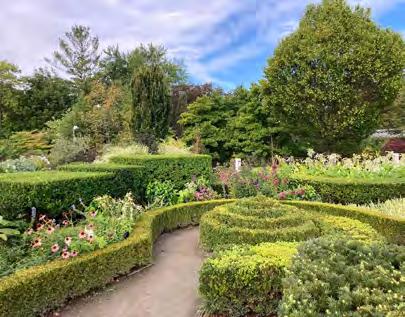
FACiLiTy REnTALS 416 397-1324 events@torontobotanicalgarden.ca
GARdEn ShOP 416-397-1357 retail@torontobotanicalgarden.ca
GARdEninG hELP LinE Toronto Master Gardeners 416-397-1345 torontomastergardeners.ca
GROuP TOuRS
416-397-4145 tourguides@torontobotanicalgarden.ca
hORTiCuLTuRE 416-397-1358 horticulture@torontobotanicalgarden.ca
AudiEnCE EnGAGEMEnT marketing@torontobotanicalgarden.ca
MEMBERShiP
416-397-1483 membership@torontobotanicalgarden.ca
TRELLiS MAGAzinE editor@torontobotanicalgarden.ca
VOLunTEER SERViCES 416-397-4145 tourguides@torontobotanicalgarden.ca
WESTOn FAMiLy LiBRARy 416-397-1343 librarydesk@torontobotanicalgarden.ca
GEorGIE kENNEdY JENNY rHodENIZEr lee robbinS
Veronica SliVa
VOlunTEEr
PrOOfrEAdErS
JAckIE cAMPBEll lYN HIckEY
Jean MccluskEY
Marg anne MorriSon roSe robertS libertÉ rEIllY
AdVErTiSinG marketing@toronto botanicalgarden.ca
Trellis is published as a members’ newsletter by the toronto botanical garden at edwards gardens 777 lawrence avenue east, toronto, ontario, M3c 1p2, 416-397-1341
Trellis welcomes queries for story ideas, which should be submitted to the editor for consideration by the trellis committee at least four months in advance of publication dates.
opinions expressed in Trellis do not necessarily reflect those of the tbg Submissions may be edited for style and clarity.
©2024
All rights reserved. reproduction in whole or in part is prohibited without the written permission of the toronto botanical garden.
Charitable registration number 119227486rr0001
777 Lawrence Avenue East, Toronto Ontario M3C 1P2, Canada • 416-397-1341 fax: 416-397-1354 • info@torontobotanicalgarden.ca torontobotanicalgarden.ca • @TBG_Canada
By TTC
From Eglinton subway station take the 51, 54, 54A or 162 bus from Lawrence Subway Station to Lawrence Avenue East and Leslie Street. The TBG is on the southwest corner.
Find us on...




